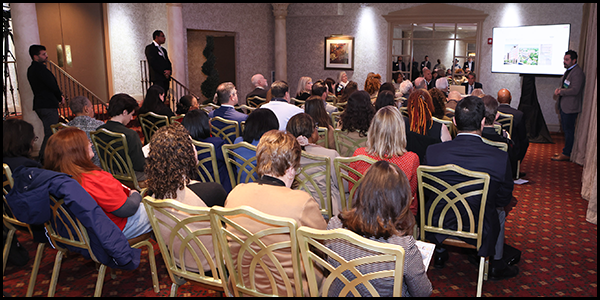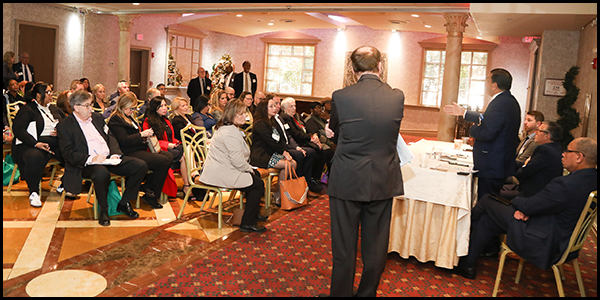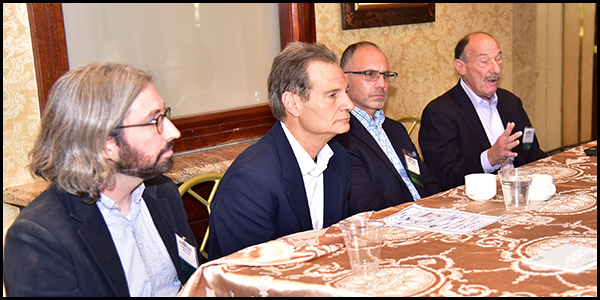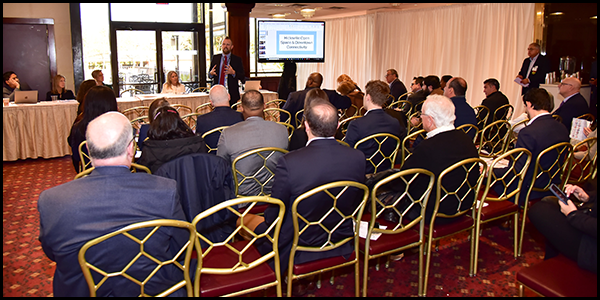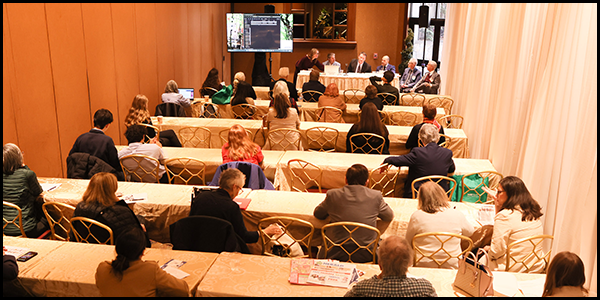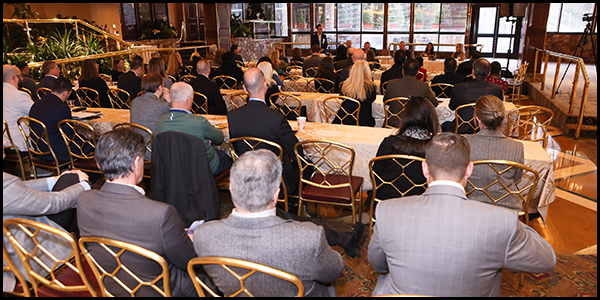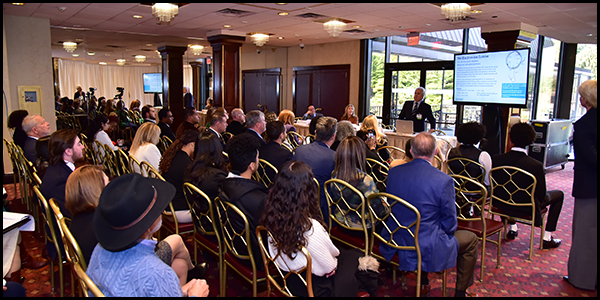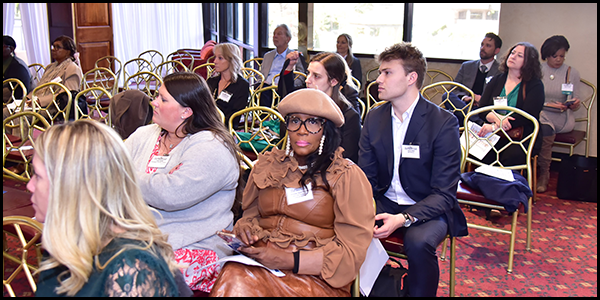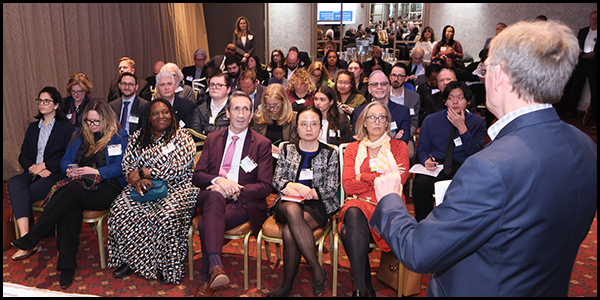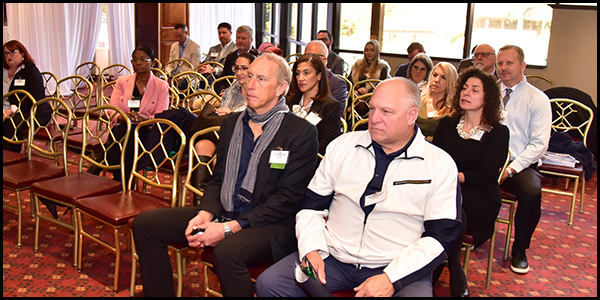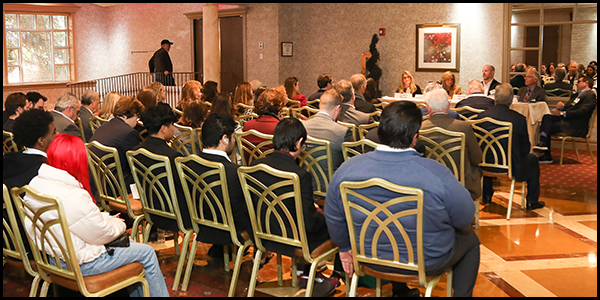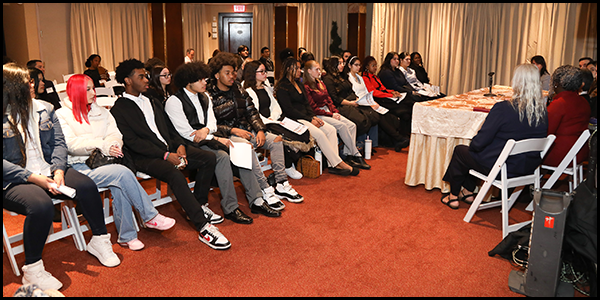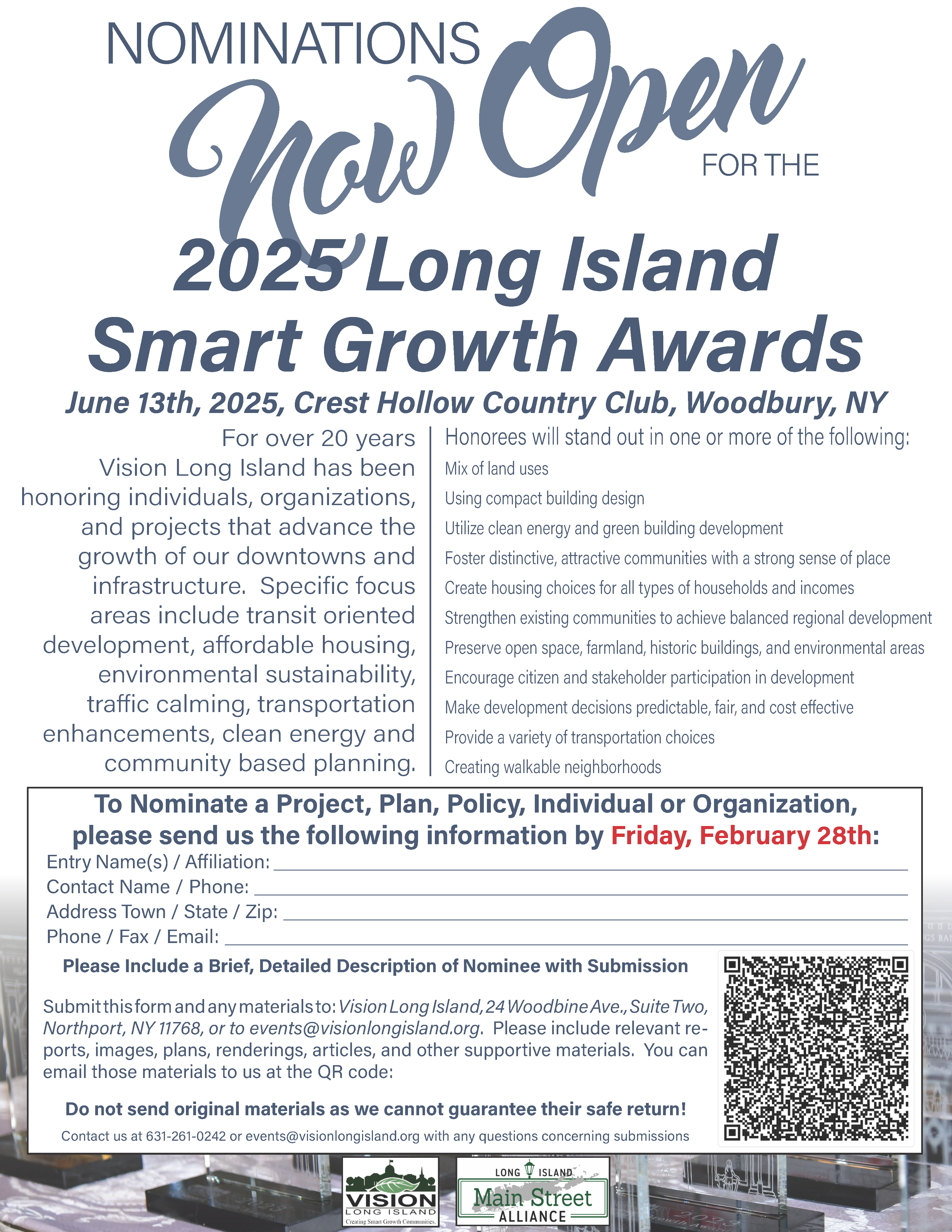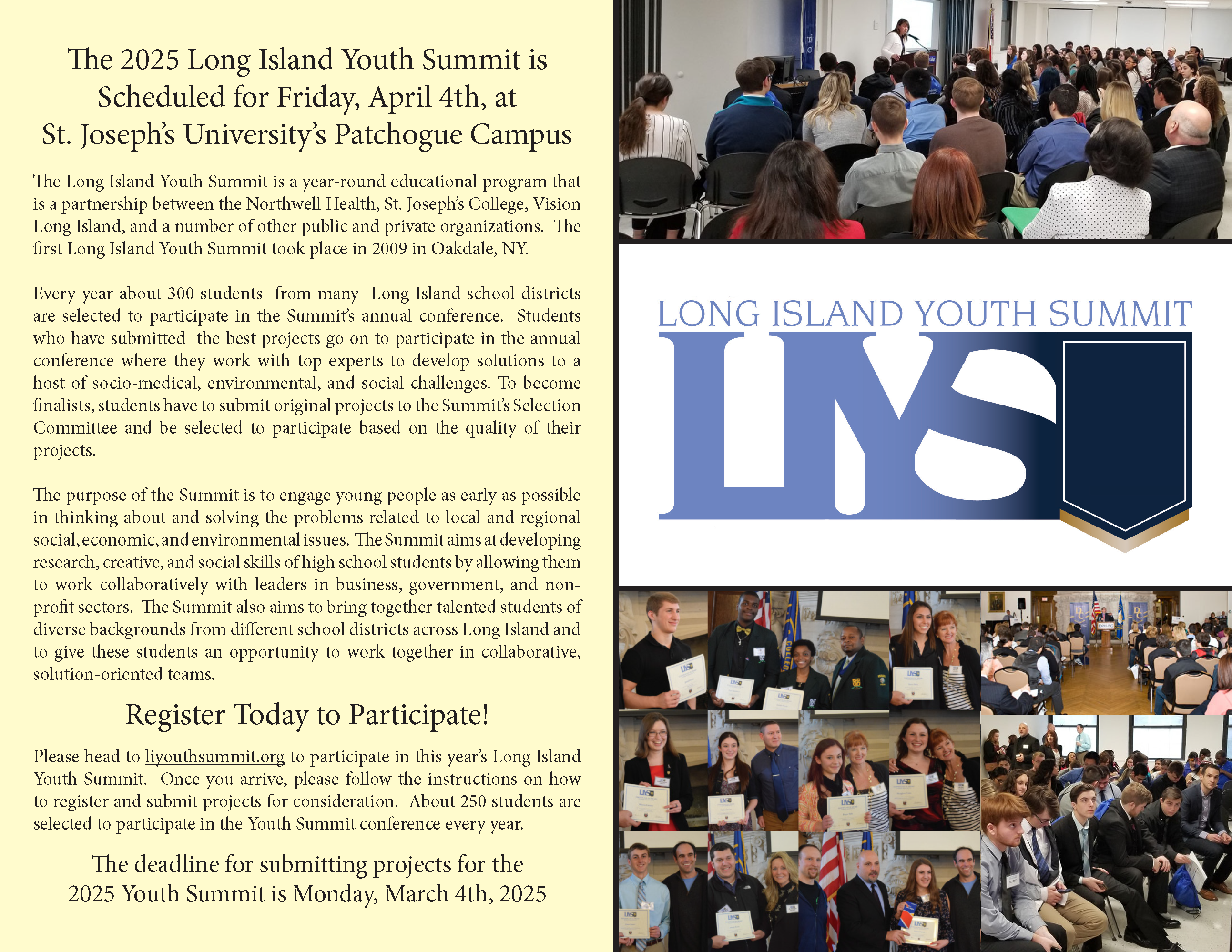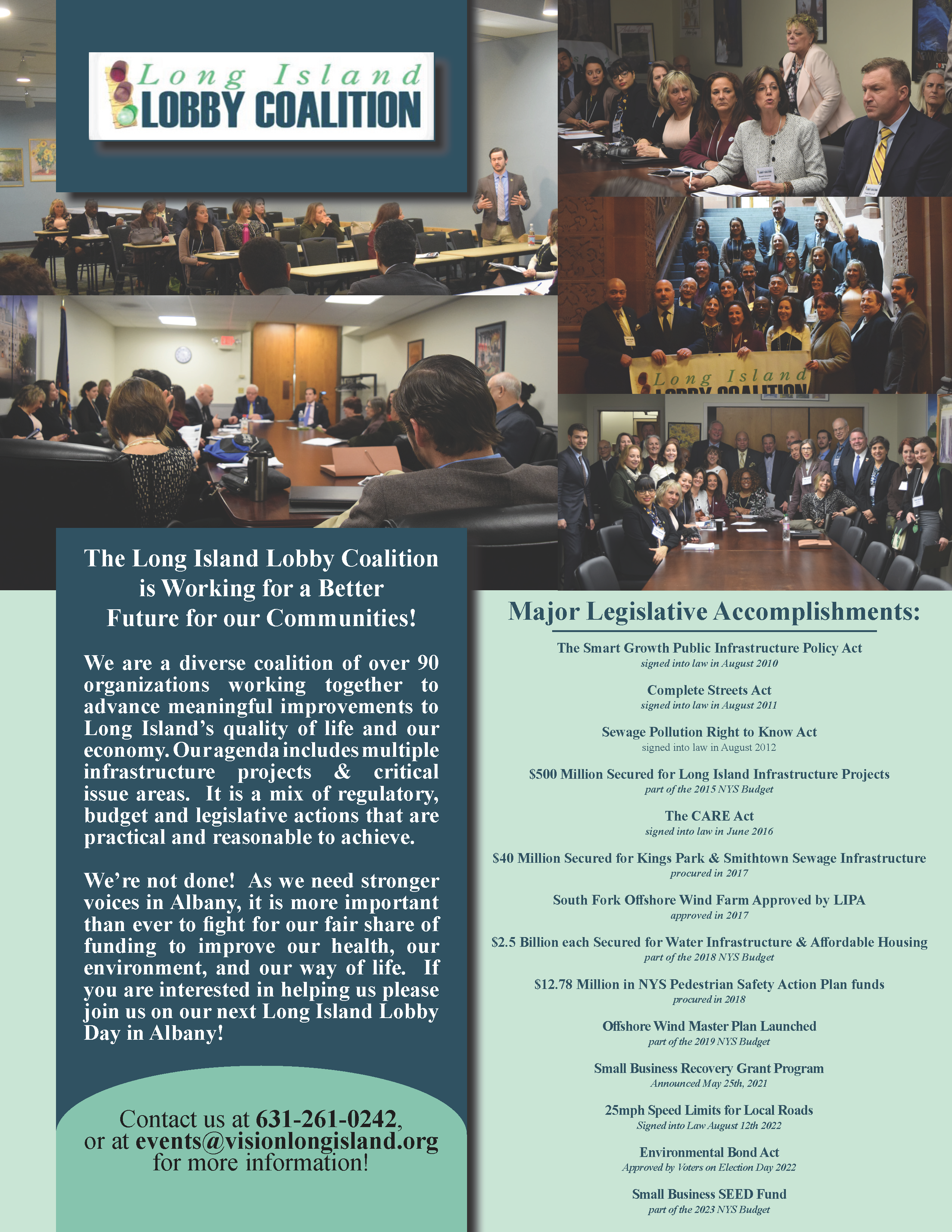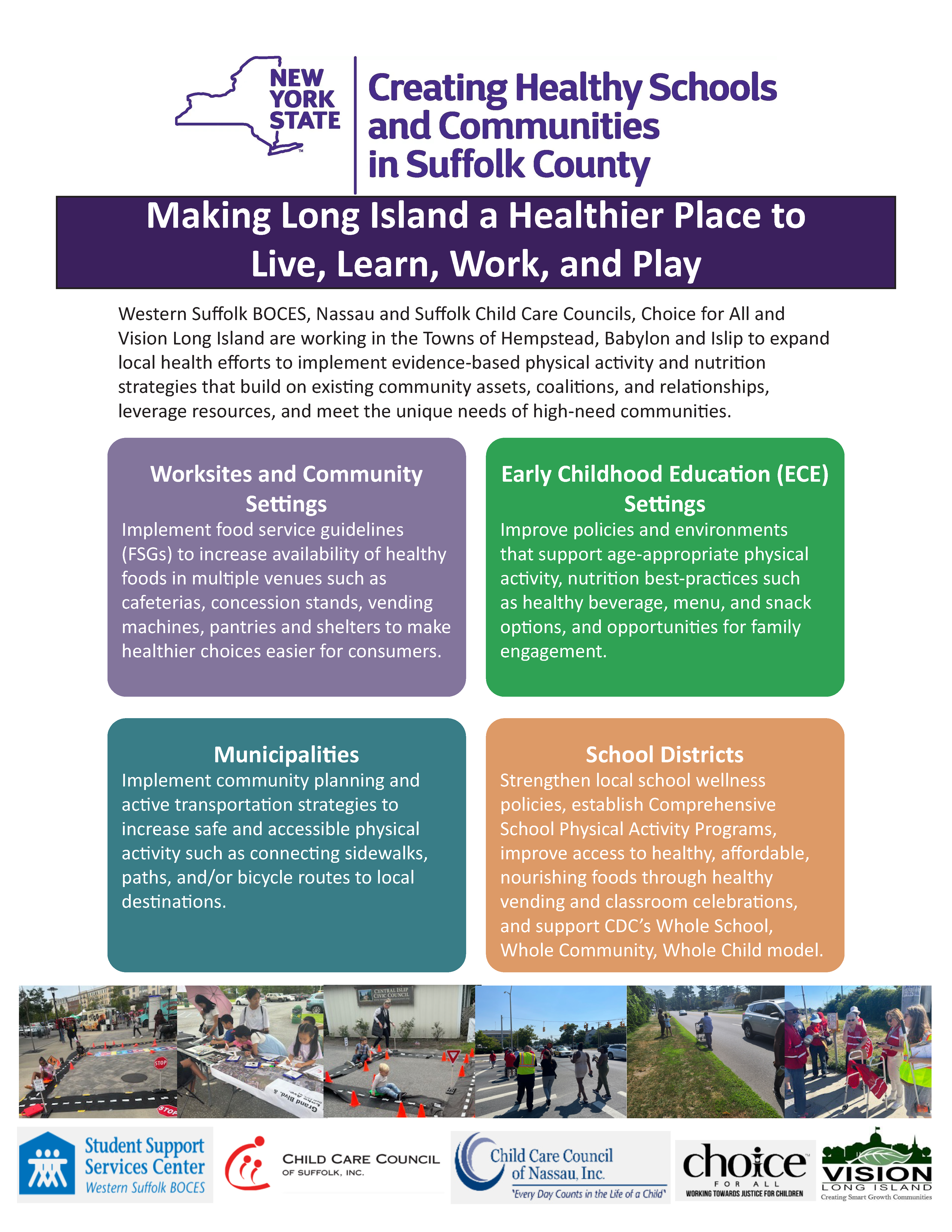
December 6, 2024 - Crest Hollow Country Club, Woodbury

Over 1,000 LONG ISLAND COMMUNITY, BUSINESS & GOVERNMENT LEADERS UNITED
TO “Plan locally” & Advance Downtown Redevelopment & infrastructure
Over 1.000 local business, community and government leaders joined this year’s LI Smart Growth Summit at the Crest Hollow Country Club in Woodbury. 20 worksessions featuring over 120 speakers focused on topics related to helping small businesses, “planning locally” for new housing options, downtown revitalization and infrastructure investment. “Planning Locally” comes down to municipal officials and communities, 12 of whom gave local updates on the State of the Town’s and Village’s Panel. The 2024 panelists included: Town of Brookhaven Supervisor Dan Panico, Town of Smithtown Supervisor Ed Wehrheim, Town of Huntington Supervisor Ed Smyth, Town of Oyster Bay Supervisor Joseph Saladino, Town of North Hempstead Supervisor Jenn Desena, Town of Riverhead Supervisor Tim Hubbard, Village of Westbury Mayor Peter Cavallaro, Village of Farmingdale Mayor Ralph Ekstrand, Village of Valley Stream Mayor Ed Fare, Village of Amityville Mayor Dennis Siry and City of Glen Cove Mayor Pamela Panzenback. This session was moderated once again by Newsday’s Joye Brown.
This year’s Summit will featured a luncheon session with the NYS Comptroller Tom Dinapoli who provided an update from Albany on NYS’s fiscal health and what is in store for 2025.
NYS Senator Jack Martins gave a preview of the 2025 Albany legislative session.
Fresh off of a victory on a referendum for Clean Water and wastewater infrastructure funding Suffolk County Executive Ed Romaine was a featured speaker and covered the work his administration is putting in place for our downtowns, safe roadways, affordable housing and bus service and infrastructure.
Suffolk County Presiding Officer, Kevin McCaffrey covered their efforts to help Suffolk’s Main Streets.
Brian Sapp from National Grid will spoke at an afternoon session to share the company’s investment in Long Island communities.
Their support for a multichamber outreach effort secured LI Small businesses $111 million out of a NYS fund of $800 million in relief funds to recover from Coronavirus.
Transportation, clean energy and water infrastructure and Complete Streets professionals are presenting. MTA/LIRR President Rob Free and LIPA Acting CEO John Rhodes were among the featured speakers in these sessions.
Sessions on affordable housing, condo and ownership options, TOD, Major Development Projects, Cutting the Red Tape and Commercial Development transformation were held. Nearly a dozen developers shared their projects and plans working with local communities and municipalities.
The Long Island Main Street Alliance will had members out from 40 different downtown communities that have plans for managing Main Street, future growth and preservation. Their collective work has secured funding from NYS DRI and NY Forward programs where we will have revitalization presentations from Westbury, Hicksville, Riverhead, Baldwin, Huntington Station and Kings Park.
We held a session dedicated to small business resources with local chambers moderated by Newsday’s longtime business writer James Madore.
To address the needs of our many dangerous roadways there was a session focused on speed reduction through road design.
A LI Youth Summit incorporating students from St. Joseph’s University, Hofstra University, SUNY Farmingdale and local high schools commenced for the 17thstraight year bringing young people into the planning process of their communities including workforce training, mentoring to navigate potential jobs.
“This year’s Summit provided a roadmap for community, business and government leaders to work together, heal the divisions thrown at us from Federal, State and regional interests and “Plan Locally” to uplift our many local communities in need.” Eric Alexander, Director, Vision Long Island and Founder of the LI Main Street Alliance.
The summit began with its customary and informative State of the Towns and Villages Plenary Session, followed by seventeen work sessions. The program focused on topics related to helping small businesses, including “planning locally” for new housing options, downtown revitalization, infrastructure investment, and more.
This luncheon session followed, featuring New York State Comptroller Tom DiNapoli; New York State Senator Jack Martins; Suffolk County Executive Ed Romaine; and Suffolk County Presiding Officer Kevin McCaffrey.
Eric Alexander, Director of Vision Long Island and the Long Island Main Street Alliance, began the summit by taking a moment to acknowledge the passing of community and government leaders that had been mainstays at Smart Growth Summits throughout the years, including Westbury Village trustee William Wise, Hempstead Town Councilman Chris Carini, and founder and president of the Concerned Citizens of the Plainview-Old Bethpage Community Carol Meschkow. “They have meant so much to us,” Mr. Alexander affirmed.
State of the Towns and Villages Plenary Session

The summit’s traditional State of the Towns and Villages Plenary Session brought to the dais elected officials from all across Long Island. The session was moderated by Joye Brown of Newsday who drilled down on some of the most important issues and needs facing local towns and villages right now.
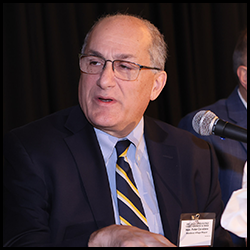
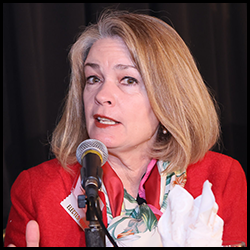


Hon. Peter Cavallaro, Westbury Village Mayor – We talk a lot about the need for infrastructure, but we must also talk about the effect that building one or two projects has on a downtown. Once you do one or two projects, then you start attracting more and more money, not only from private developers, but also from the state and the federal government.
In Westbury, we are in the process of implementing what we put in place right before COVID. As a result of our DRI project, we did a rezoning of 52 acres near our train station. Even before that we had about 800 units of multifamily housing in our downtown, now we have the potential of adding up to 1200 more units near our downtown.
Hon. Jennifer DeSana, North Hempstead Town Supervisor – We are an island. We are very different from the rest of New York State. We have water needs, we have transportation needs, we have garbage needs. We need regional solutions. We need to keep working together, collaboratively, to make sure that we are doing our best for Long Island and make sure we do not get a cookie cutter approach from Albany.
North Hempstead is building. Look at Mineola, Westbury, and Great Neck, we have a lot of apartment buildings. In North Hempstead we are now focused on where we can build more. We can say when we build different types of housing, we are not going to explode our schools. We have made changes in our building department. We cut taxes three years in a row. We have an incredibly growing diverse population in North Hempstead and we are celebrating that we have very high quality education.
Hon. Ralph Ekstrand, Farmingdale Village Mayor – We are environmentalists first and foremost. We have already had contact with the incoming new cabinet member of the EPA to help get the Grumman Navy plume cleaned up and make sure the contaminants in the ground at Bethpage Community Park are fully removed and shipped off Long Island. Long Island needs money from the federal government, including water funding.
Regarding adding housing to our downtown, Farmingdale has been successful. This month and next, we are opening 110 units of new downtown housing in our village, where over 500 units already exist. What is unique about this phase is a 78 unit complex is 100% affordable housing.
Hon. Ed Fare, Valley Stream Village Mayor - When we mention infrastructure and funding, we have to remember our infrastructure is aging. Water main breaks are a constant occurrence.
Valley Stream has multiple developments going on. We look at cycle of life - seniors, workforce housing, firefighters, police, etc. We have put in well over 1000 units and we have four or five projects in the works.
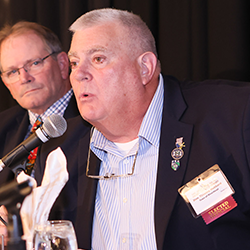
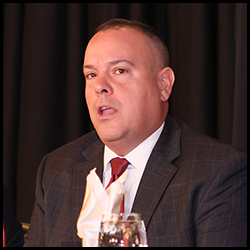
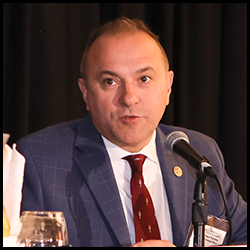

Hon. Tim Hubbard, Riverhead Town Supervisor – Riverhead happens to be one of the fastest growing towns in Suffolk County, if not on the Island. We are in the middle of a huge revitalization of our downtown area. We have more affordable housing than all of the five East End towns. That being said, we do not have enough housing for our young people that are just starting out. So when we have developers come in and they look to do a project of 30, 60, or 80 units, we are asking them to provide a percentage of affordable housing as part of those units.
Hon. Dan Panico, Brookhaven Town Supervisor - Regarding funding, we need more from New York State than the federal government.
When we talk about building units and revitalizing, I do not think we can avoid the elephant in the room. When the state tried to take over local zoning a couple of times, it poisoned the minds of so many people and it will continue to have a ripple effect for so many more years.
Hon. Pam Panzenbeck, City of Glen Cove Mayor - Water infrastructure is the most important thing for us right now. Our infrastructure is antiquated. We suffer from water main breaks every time the temperature changes. We have gotten some great grants, but it would be wonderful to just get money that we do not have to borrow, which includes fees, and then wait to be reimbursed.
In Glen Cove, we have spent a year and a half on developing a new comprehensive plan which was way overdue. Government officials, people from the community, the Chambers of Commerce, the hospital, and more were invited to participate. We feel that we came up with a great comprehensive plan. We are voting on it at our meeting at the end of December. We are presently looking at a workforce condo project and have a number of projects in the pipeline down in the Village, such as a theater.
Hon. Paul Pereira, Village of Mineola Mayor - You have to be bold, courageous, transparent, and believe in your vision. If you do that, you will be successful.
In Mineola, transit oriented development has been leading the way, long before it was a thought from Albany. We developed a master plan and in the last 12 years we have built over 1200 units of multifamily housing. We have approximately. 900 units in the pipeline. That will bring us over 2000 units in about 15 years and all of it is by our train station.
Hon. Joseph Saladino, Oyster Bay Town Supervisor – Money for infrastructure projects large and small is important. A sewage treatment plant could cost over a billion dollars. We need to focus on how we get our sanitation off Long Island. We have been calling for the dialing back on the unfunded mandates. We need the federal government’s help in Oyster Bay.
Regarding development, the DRI downtown revitalization initiative has been very successful. The stakeholders, the community, are deciding what goes there. We are building over 534 units in the coming months. We have already broken ground on the Alpine development, a $111 million project with 227 units; Fieldstone on Broadway, 141 units; the Bank of America breaks ground this coming year; and the W Cherry townhouses, at 37 W Cherry Street, is also breaking ground.
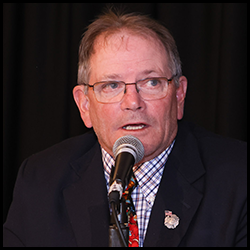
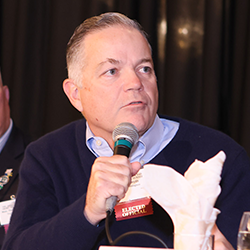
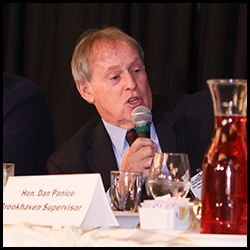
Hon. Dennis Siry, Amityville Village Mayor – Regarding help from the federal government, we are concerned about the new OSHA rules regarding training, which will crush any type of volunteer fire department. Just like we said with the attempt by the state to take away home rule, one-size-fits-all . does not work regarding OSHA’s training.
Amityville is spending its DRI money and working on smart growth within its downtown. We are moving forward with our active transportation study. We have increased our housing by 10% over the last four years by adding about 600 units of housing. That is adding almost 1000 residents to our population of 10,000. We do need help with our infrastructure, especially regarding water mains.
Hon. Ed Smyth, Huntington Town Supervisor – Our focus in Huntington for the past three years has been infrastructure. We need money for roads, highways, sewers, sea walls, and more. We need money with the fewest restrictions and strings attached as possible.
As far as the state's participation in towns and villages, if you can see it above ground the state should probably not be involved in it. In terms of the state’s attempt in taking over local development, it is going to have a ripple effect for years. Nobody trusts Albany. Everything coming out of Albany now is looked at skeptically.
Hon. Ed Wehrheim, Smithtown Town Supervisor – Something that has to be addressed in Washington is the time it takes to get federal funding back to the municipality. You apply for grants, but it can take three to four years to get the money. I think getting the money timely is as important as getting the money at all.
Regarding development, over the last couple of years, it is getting easier than it was before. We are working on three business districts in Smithtown, all with railroad stations located in them. We are at about 500 units, have sewers completed in Saint James, are underway in Kings Park, and we are working on Smithtown.
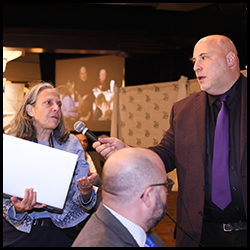
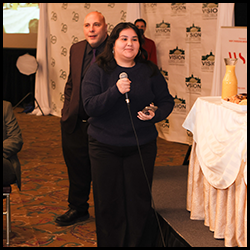
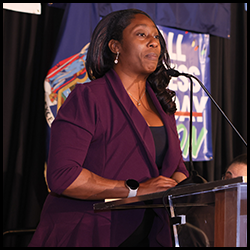
Student Question – A well informed student from Amityville High School asked the elected officials, “One of your main talking points was discussing high property taxes for the residents of Long Island. Finding ways to lower taxes would help residents stay, especially younger residents. Many Long Island communities are inviting developers to build apartment complexes and having them pay a PILOT, which is generating less revenue for communities and school districts, thereby putting an additional tax burden on homeowners. What can be done to improve this situation?”
The panelist response was unanimous, if businesses are going to thrive, Long Island’s crushing tax burden has to be alleviated. Development often happens on properties that were either paying little or no taxes. When something is developed, the tax base is actually increased. The cost of living on Long Island has gone up, but it is not because of PILOTS. Developers have said if they do not get a tax abatement, they are not going to be able to build.
The panelists also discussed other issues including residents high cost of living expenses on Long Island, development’s impact on school districts, walkability of downtowns, regional waste challenges, and more.

You can view the complete State of the Towns and Villages Plenary session here.
Creating Affordable Housing

Participating in the Creating Affordable Housing panel were Peter Florey, D&F Development; Ralph Fasano, Concern Housing; David Gallo, Georgica Green Ventures; Leah Jefferson, Suffolk County CDA; Trish Calandra, THRIVE; and Sharon Mullon, LI Housing Partnership, Moderator.
Peter Florey of D&F Development started off the panel discussing the status of affordable housing on Long Island. “In general, on the housing front, I would say there are some really good things that have happened, but we are definitely facing some headwinds. On the good news front, there is certainly money available.” Mr. Florey discussed New York State’s Pro-Housing Community Program, which he hopes will be expanded. “On the headwind side, we are severely challenged because of high insurance costs,” he explained, referring to New York’s Scaffold Law. Additionally, collections has been difficult since COVID, noting courts are very backed up. Mr. Florey also gave a run down of some of D&F Development’s recent projects, including Matinecock Court in East Northport, Sterling Green in Farmingdale, and Allegria South in North Bellport.
Ralph Fasano of Concern Housing discussed the need for supportive housing, explaining how the shuttering of New York State’s psychiatric centers left a tremendous hole. Discussing one of the challengers in developing this type of supportive housing, Mr. Fasano stated, “It's not uncommon for us to get a pretty intense opposition because of what we do.” His goal often is to reach out to civic groups, not necessarily to get their support, but to get them to agree to not oppose the project. Mr. Fasano also discussed another challenge, finding appropriate sites to develop, where you can get approvals, where you can build your own sewage treatment plant or hook up into existing sewers, and where the community will not oppose the development. To address this, Concern is now working with faith-based organizations that have land, buildings and most importantly have a mission that is compatible with what Concern does. “We are working with the Sisters of Saint Joseph and the Sisters of Saint Dominic.” Mr. Fasano discussed some recent projects, including Liberty Station in Port Jefferson Station.
“Housing matters,” David Gallo of Georgica Green Ventures stated. “This is why I started Georgica Green. Its mission has always been that affordable housing has a place in every community and that diversity of race and diversity of income and diversity of age make our communities better and our children smarter. We pride ourselves on being able to work with communities and to demonstrate to elected officials, community boards and residents that yes, although we are building housing for the people working there, it will actually end up being a benefit to the entire community.” Mr. Gallo spoke about many of Georgica Green’s projects, including The Green at Gardiner’s Point, a collaboration with the East Hampton Housing Authority, The Green at Garvies Point in Glen Cove, Sandy Hollow Cove in Southampton, and The Vue, a mixed-use apartment building in Riverhead.
Leah Jefferson, Director of Community Development for Suffolk County, explained, “Whereas the county doesn't actually have authority for overseeing housing, we do have funding available to work in conjunction and partnership with towns, with villages, and with municipalities. Right now the county is working with municipalities to provide home funds. We are trying to tap into as many resources as we can.” Ms. Jefferson spoke about a new county initiative wherein Suffolk County is not going to put acquired properties immediately on auction, it is going to choose people to develop these properties as affordable housing, noting that she is presently looking at a large piece of land in Riverhead. “The number of homeless in Suffolk is up, with the majority of those finding themselves homeless for the first time being single women with children. We are exploring opportunities to provide nonprofit housing for those in need, which will give them safety and dignity.”
“We can help people with disabilities stay in their local communities, in the houses they know. With that in mind, THRIVE started a regional housing collaborative which deals with different initiatives,” Trish Calandra of THRIVE explained. These initiatives include partial real estate tax exemptions which bring equity and fairness that will help more disabled New Yorkers afford to remain in their homes and communities; funding set aside for housing people with disabilities; and New York State’s Plus One ADU Program, which is an initiative to create and improve Accessory Dwelling Units so people with disabilities can live in safe and quality housing. By letting people live in the community of their choice, not in a group home model, but through a new program called Self Direction, people will thrive.
You can view the complete Creating Affordable Housing session here.
Transportation Update

Participating in the Transportation Update panel were Rob Free, President, MTA/LIRR; Jack Khzouz, NICE Bus; John Corrado, Suffolk Transportation Service; Marlon Taylor, NY & Atlantic Railways; Nancy Vargas, DH2 Chauffeured Transportation; and Lisa Daglian, PCAC, Moderator.
“I am very excited to say there has been a lot of positive changes to our system, to our service, and to our resolve to significantly improve the services we provide,” Rob Free, President, MTA/LIRR stated. “First and foremost, our staff is focused on safety, reliability and customer experience. As a result of that focus, in November we had our highest on-time performance in our recorded history, 96.2% on time.” Post COVID, LIRR ridership numbers are remarkable. Five strategic priorities for the company have been identified: operate safe service; improve the customer experience; build a better railroad; run efficiently; and energized and develop its workforce. “Right now, we have our 2025 to 2029 capital program that the MTA Board has approved. We are awaiting approval from Albany,” Mr. Free explained. “Some of the numbers include $1.57 billion to be spent on rolling stock and 1.2 billion on station upgrades.”
John Corrado with Suffolk Transportation Service discussed Suffolk County’s progress after launching Reimagine Transit, an initiative to rethink the entire network of Suffolk County Transit bus routes to ensure that the county is making the best use of its resources. “We now have less routes, but with more frequency. We did abandon some neighborhoods and it is on the county’s mind. The County Executive has already written to the governor asking for money to enable micro transit and flexible demand service to get service back into some of those neighborhoods.” Ridership is now just about where it was pre COVID. There has been 30% year over year growth and another 10% growth is expected in 2025. Cost per ride has also gone down. “We also provide the paratransit system for Suffolk County, providing about 2000 trips a day,” Mr. Corrado stated. One problem that has arisen is the issue with shelters. “Folks are trying to actually live inside our shelters,” he explained. “Some of the towns have taken the shelters down. This is being addressed by redesigning the shelters. We are rebranding the system in general. Our next goal is to connect the present camera system to a real time crime center at Suffolk County Police. We are going to apply for a grant to get this done.”
Discussing NICE Bus, Jack Khzouz stated, “First and foremost, we are a private contractor. We have a very small staff, but we handle everything on behalf of Nassau County.” NICE Bus has more riders now than pre COVID times. “The post COVID world has made us better because we think a little differently. How can we clean our vehicles more often? That is an important aspect of ridership. We clean our buses three times a day now.” NICE Bus, a fleet of about 450 vehicles, runs both paratransit and fixed routes. It is primarily a compressed natural gas fleet. “It is one of the largest compressed natural gas fleets in the country,” Mr. Khzouz explained. “We run every 15 minutes throughout the day, every day, and all through the night. We are presently putting up a state-of-the-art charging station that will handle about 25 electric vehicles when it is fully up and running, helping with efficiency. We are also taking delivery of 41 new CNG buses in 2025, which will certainly help with our reliability. We have to look at integration. How do we support the railroad system? How do we support Suffolk County and the MTA?”
Nancy Vargas, CEO of DH2 Chauffeured Transportation, described her business as a much smaller organization than her fellow panelists, but noted they do make an impact not only on Long Island, but within the entire New York area. The business has a diverse fleet of about 25 to 28 vehicles and provides transportation service and mobilization. “We are providing shuttle services today. That is our niche,” Ms. Vargas explained. The company focuses on private transportation services for universities, hotels, employees, or just one passenger. Located at JFK airport, it is also able to focus on flight crew and distressed passengers. “We continue to evolve. We have been speaking about how we can evolve and what the future holds for sustainability. One of the things that we are working on is providing, operating and managing an electric vehicle station for one of the terminals at JFK. We just broke ground,” Ms. Vargas stated. “We are certainly looking forward to seeing how we, as a small private company, can collaborate with companies that provide a larger scale transportation service.”
Marlon Taylor, President of NY & Atlantic Railway, explained that NY & Atlantic Railway began operations in 1997 with an agreement with the Long Island Railroad to provide freight services over their network. “Our customers are bringing to market products, food, recyclables, waste and plastics,” Mr. Taylor explained. According to Mr. Taylor, freight rail is 75% more efficient and environmentally friendly than other modes of transportation. “Today we are removing 120,000 truck trips from the streets.” NY & Atlantic Railways holds the common carrier obligation for the LIRR. “The Long Island Railroad cannot refuse freight service or freight customers, so we carry that responsibility on its behalf. When Posillico needs aggregate for their construction projects, we have to provide that for them. When Paraco Gas needs propane, we have to provide that for them. When Waste Management or Winters Bros. needs waste removed from Long Island or New York City, we have to provide that service,” Mr. Taylor explained. NY & Atlantic Railway’s job is measured by its impact to passenger service.
You can view the complete Transportation Update session here.
TOD & Downtown Revitalization

Participating in the TOD & Downtown Revitalization panel were Andrew Zucaro, Zucaro Construction; Maria Masi, Mill Creek Residential; Sal Coco, BHC Architects; Peter Scully, Hayduk Engineering; James McCabe, Alpine Residential; Anthony Bartone, Terwilliger and Bartone; and John Chillemi, RMF, Moderator.
Andrew Zucaro, Zucaro Construction, discussed some of his company’s current projects, including Village By The Bay in Amityville, which is 117 units right at the train station, and The Lofts in Smithtown, which is five buildings and 74 apartments. “We just broke ground in Babylon in the middle of Deer Park Avenue, which will be 27 apartments over seven stores,” Mr. Zucaro described. Regarding the typical process of community development, Mr. Zucaro noted identifying a project site is hard enough, but efforts get really hard when you start to negotiate the pricing. “Then you have to certainly work with an IDA, otherwise most of these projects will not work,” he underscored.
Maria Masi of Mill Creek Residential noted the company has had projects in the past on Long Island in Hempstead, West Hempstead, and Mineola. However in the past two or three years, they have not been able to push projects through the pipeline, which they hope will change. “The company currently has projects going in Glen Cove and is looking at some other opportunities in Bay Shore and Westbury. Hopefully with a little bit of work and a little bit of elbow grease, we are going to get things going,” Ms. Masi stated. To Mill Creek, density is an important factor when considering a project. “Unfortunately, we cannot deal with small projects like 30 units. It would never get approved by our investment committee. Fifty units would be very hard also. For us having a certain scale is very important, which makes it even harder to get projects completed,” Ms. Masi concluded
“Transit Oriented Development is a big part of our work,” Sal Coco of BHC Architects stated. The firms TOD projects can be found throughout Long Island, including in Port Jefferson, Hempstead, Baldwin, and Bay Shore.
“Hayduk Engineering is a full service civil engineering firm,” Peter Scully explained. “We do a lot of site design, wastewater, and transportation.” Projects include The Lofts in Smithtown, 180 Deer Park Avenue in the Village of Babylon, and Station Crossing in Port Jefferson Station. Discussing infrastructure, Mr. Scully stated emphatically, “You cannot have density without wastewater infrastructure. Herein lies the real challenge, there is a difference between Suffolk County and Nassau County. Nassau County is about 75% sewered, while Suffolk County on the other hand is 75% unsewered. Successful TODs are in places where sewers are available or where sewer infrastructure was created.” Speaking about the future, Mr. Scully stated, “I think the good news is that for the first time Suffolk County now has a long term plan that calls for sewering many of the downtowns. The people Suffolk County on Election Day voted to approve a new funding source to make wastewater infrastructure happen.”
James McCabe of Alpine Residential discussed two projects on Long Island. The first is 189 units, with 7,000 square feet of retail, right by the Hicksville train station and the second development is in Westbury, with 187 units, also right by the train station. Both projects feature underground parking. “In Hicksville, we probably worked over a year with the Town of Oyster Bay to address all of its concerns. All these development districts have requirements, but there are all these nuances that towns want, which comes via feedback from their community,” Mr. McCabe stated.
“My company has a bias towards Transit Oriented Development,” explained Anthony Bartone of Terwilliger and Bartone. Some of its notable TOD projects can be found in Farmingdale, Lynbrook, and Westbury. “Westbury is the only building on Long Island that has direct access to the train platform,” Mr. Bartone added. Projects in the pipeline include Kings Park and Hicksville. Discussing zoning, Mr. Bartone stated, “There are only extremely small areas on Long Island that have zoning that permits multifamily housing. There is zoning from the 1950s in place that doesn't work today. Trying to change that is a herculean effort, it takes years and years.” One reason why TOD is so good for a downtown, Mr. Bartone advised, is that 40% of everybody's income, plus or minus, is going to be used for discretionary spending. “You can start to do the math, there are lots of commas and lots of zeros. The energy, the walkability is all palpable. You can feel it, you can see it.”
You can view the complete TOD & Downtown Revitalization session here.
Small Business Resources

Participating in the Small Business Resources panel were Luis Vasquez, LI Hispanic Chamber of Commerce; Lionel Chitty, Nassau Co. Office of Minority Affairs; Robert Fonti, Suffolk County Alliance of Chambers; Misolino Silva, Vision Long Island; Michael Presti, PSEG-LI; and James Madore, Newsday, Moderator.
Framed by moderator James Madore of Newsday, discussion focused on small businesses on Long Island, which as the moderator described, are still trying to recuperate from the effects of COVID. Adding to this are new issues including inflation, lack of available employees, increased competition, and supply chain issues.
Small business makes up a sizeable portion of Long Island’s economy, with 90% of businesses on the Island having less than 20 employees. Many of these businesses are found in downtown areas. The panelist were all associated with organizations that are about small business and helping businesses thrive. As Robert Fonti of the Suffolk County Alliance of Chambers stated, “We communicate, we collaborate and we connect.” Michael Presti from PSEG-LI added that when it comes to small and medium businesses, it is always the goal to figure out ways to work not only with chambers, but directly with business owners. Mr. Presti discussed PSEG’s economic development grants, energy efficiency offerings, Main Street Revitalization Program, and Vacant Space Revival Program, all which help small businesses, especially during the critical first year.
The panel engaged in a Q & A session, answering questions from audience members about grants, loans, and other financial assistance.
When asked by an audience member what resources are available to help expand his trade school, Lionel Chitty from Nassau County Office of Minority Affairs told the audience member, “Right now, to the best of my knowledge, Google is going to be your best friend, but be careful.” Mr. Chitty also discussed Long Island’s two Community Development Financial Institutions, which specifically help small businesses. Mr. Fonti added that there are a number of grants available for small businesses, all which can be found on the Suffolk County Alliance of Chambers Facebook page.
The topic of becoming a certified Minority Or Women-Owned Business Enterprise (M/WBE) in New York State was discussed. Its benefits include access to government contracts, networking opportunities, financial counseling, and business funding opportunities. “NYS is presently doing free counselling to help small businesses regarding this certification through various organizations such as the Entrepreneurs Assistant Centers at Suffolk County Community College and Hofstra University,” Mr. Madore explained.
Luis Vasquez from the LI Hispanic Chamber of Commerce noted that it is a long process. “Getting the certification is one thing, getting the contract is another.” Misolino Silva of Vision Long Island, discussing working with small businesses, added, “Eight times out of ten, unfortunately, it is almost like pulling teeth. You also have to do the work. You have to help us out. We are there, knocking on doors, trying to assist. Please do what needs to be done in order to help us be successful at granting you the money that is available.”
You can view the complete Small Business Resources session here.
Clean Energy Resources

Participating in the Clean Energy Resources panel were John Franceschina, TRC Companies; Andrea Bonilla, Vineyard Offshore; Shawn Harrison, NYPA; Gina Farese, Marcor Solar; Will Frost, East Point Energy; and Neal Lewis, Sustainability Institute, Moderator.
The world of energy is going through a major transition right now, Moderator Neal Lewis from the Sustainability Institute at Molloy University began. Mr. Lewis motivated the crowd by saying, “Although the challenge is very real, we are making some progress.”
John Franceschina of TRC Companies described TRC’s work as overseeing a whole host of different types of energy and sustainability support services for utilities and governments. “We have been doing a lot with solar, wind, and battery storage lately, all which help us as we change our energy infrastructure around Long Island,” Mr. Franceschina explained. “Through energy efficiency programs, we have been able to reduce demand, so usage has come down. Now we are focusing on electrification. The plan is to increase the clean energy resources as demand increases. Based on the existing technologies, we have been able to put in LED lighting controls and energy efficiency metrics, which basically enabled us to reduce what would be equal to a 20 MW power plant every year.” The goal is to be zero emissions by 2040. “It is achievable,” Mr. Franceschina stated.
Andrea Bonilla with Vineyard Offshore discussed why off shore wind is so successful in the northeast. “The technology has been around for a long time. We have some of the best wind resources in the world in the northeast. It is consistent wind. Wind is also complimentary to solar. Solar peaks in the daytime and in the summer, but wind is a bit more night and winter peaking. It is a complimentary resource. Most importantly, the northeast has pretty shallow sea beds,” Ms. Bonilla explained. Wind is a large scale generator, usually called a commercial or utility scale project because it goes straight into the grid. Ms. Bonilla discussed the company’s pending project, Excelsior Wind, which will be located about 24 miles off shore, with the capacity of 1.3 GW, powering potentially 700,000 homes in New York with clean energy.
Gina Farese of Marcor Solar started by explaining there are so many moving parts to a solar project, whether it is residential, commercial or industrial. “It is essentially putting penetrations in your roof,” she stated. “The good parts of solar is getting reduced energy costs, increasing your property value, and supporting a clean environment,” Ms. Farese explained. “Doing your research is important. Questions need to be asked regarding who are you hiring? Who is actually doing the physical work? What is happening in the industry is that there is a lot of ambiguity. There is not a whole lot of transparency regarding such items as warranties, fees and insurance.” In conclusion, Ms. Farese stated solar is a good thing, it just has to be done correctly.
Shawn Harrison, program manager for New York Power Authority’s ReCharge NY program, stated, “As we continue to transition into a more green energy intense market in New York State we will be able to help out businesses.” ReCharge NY is a statewide initiative supporting businesses and providing low cost power and economic development initiatives in New York State. It is designed to control costs and to retain and grow jobs in the state. “Currently we support investment of about $300 million a year in energy efficiency projects,” Mr. Harrison noted. All awards are made on a competitive basis. It is an incentive program so you have to apply. You can apply anytime. Regarding eligibility, Mr. Harrison stressed, “Let us determine your eligibility.”
Will Frost of East Point Energy discussed how energy storage is a critical piece of the transition puzzle, but it is facing some challenges right now. “What we do at East Point is develop grid scale transmission size standalone battery energy storage systems. We are simply building a couple of acres full of high tech enclosures containing lithium ion battery cells that connect to a substation through a transmission line and simply trade energy on a wholesale level with the network it is connected to.” Mr. Frost states it provides both cost benefits and reliability benefits. There are approximately 130 moratoriums on this type of storage across NYS right now. There are concerns about fires. “It is a very understandable concern,” Mr. Frost agreed. “The New York State Building Code does have safety requirements for energy systems and they are somewhat applicable to energy storage systems.” Mr. Frost spoke about the National Fire Protection Association (NFPA) 55 and how it is being incorporated into state code. (NFPA 55 deals with compressed gases and cryogenic fluid.) “We cannot commission a system without being approved by separate Underwriters Laboratory (UL) standards.” When asked about the weight of the systems, Mr. Frost answered, “You can build anything anywhere, it just depends on how much you are willing to pay for it.”
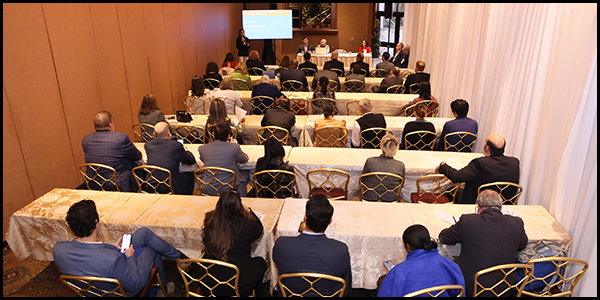
You can view the complete Clean Energy Resources session here.
Long Island Greenway Trail

Participating in the Long Island Greenway Trail panel were Danny Gold, Trust for Public Land: Stephen Normandin, NV5; Marty Buchman, New York Bike Coalition; and Jonathan Keyes, Suffolk County.
Danny Gold with the Trust for Public Land briefly discussed the Empire State Trail, which consists of 750 miles, stretching from Battery Park to Manhattan, up to the Canadian border, and from Albany to Buffalo. The project was completed in 2022. “You might have noticed that they left out Long Island,” Mr. Gold noted. New York State reached out to the Trust to take a look at mapping out a trail across Long Island. In 2018, a feasibility study was mapped out, consisting of 175 miles of trails, going from Battery Park out to Montauk. “Our main focus was to be as off road as possible.” The project has been divided up into five sections. The first section, which has been concentrated on the most to date, is 25 miles long, spanning from Eisenhower Park to Bethpage State Park to Brentwood State Park. It is 80% off road and multi-modal. “We have started on the 100% design of section one and when complete it will result in a construction documentation by the end of 2025. In 2026, we hope to get out our RFP and start construction in 2027,” Mr. Gold explained. It will be an economic driver, he stressed.
Stephen Normandin with NV5 looked at the details of the Long Island Greenway, the existing conditions, with some areas almost trail ready, especially those running along the Long Island Railroad corridor in Nassau County and the LIPA corridor in Suffolk County. “As we get into Huntington, it gets extremely challenging from a terrain standpoint,” Mr. Normandin explained. “From a design standpoint, this is a multi-use trail and everything needs to be ADA compliant. There is strict criteria to make it as level as possible. Suffolk County did all the legwork years ago, creating the North Shore Trail, working with the state, LIPA, PSEG, and the federal government to come to an agreement on liability and maintenance. This is the key to the Long Island Greenway project. It is the template, it is the roadmap and the fact that it can be done is the biggest element here. It can be done.”
“Long Island deserves this, Suffolk County residents deserve this,” stated Jonathan Keyes, Director of Downtown and Transit Oriented Development, Suffolk County. “Long Island deserves this piece of infrastructure to really be able to ride across New York State.” Discussing Suffolk County’s Hike and Bike Masterplan, Mr. Keyes stated, “The masterplan details over 1200 miles of proposed hike and bike facilities that can be seen as the veins and capillaries out from the main trunk line, the Long Island Greenway Trail. The Long Island Greenway is incorporated into that masterplan. The Suffolk County Hike and Bike Masterplan will function to get you from your house safely up to the Greenway.”
Long Island can be the most challenging place to ride,” stated Marty Buchman with New York Bike Coalition. “This could be the single most visionary thing that we do to transform what Long Island is.” Suffolk County was designed as a rural county. It was never designed for a broader population, Mr. Buchman explained. “Now you have roads choked with traffic and no alternatives. In Europe, bikes and cars do not compete for space. This can be something that will build on Long Island’s tourist attraction. Cyclists are wallets on wheels. The trail will also serve as vehicles for some people to get to work and those people are often silent.”
You can view the complete Long Island Greenway session here.
Nassau & Suffolk County Downtowns

Participating in the Nassau & Suffolk County Downtowns panel were Lou Bekofsky, VHB, Baldwin; Vicki Walsh, Councilwoman, Town of Oyster Bay; Timothy Zike, Deputy Commissioner, Town of Oyster Bay, Hicksville; Anna Vikse, Village of Westbury, Westbury; Dawn Thomas, Town of Riverhead CDA, Riverhead; Edward Lamson, BJH Advisors, Kings Park; Anthony Aloisio, Town of Huntington, Huntington Station; and Sarah Oral, IMEG Corp., Moderator.
Moderator Sarah Oral of IMEG advised the focus of the panel was the New York States Downtown Revitalization Initiative (DRI) and New York Forward, noting each of the panelists have benefited from these state programs which give grant money to help projects that will revitalize downtowns.
Lou Bekofsky with VHB discussed Baldwin’s 2019 DRI award. “At the time of the DRI, Baldwin was really positioned for development. They had a rising population. They had a pretty strong transit use and there was obviously a need for diverse and affordable housing in the area. They have a great downtown corridor on Grand Avenue,” Mr. Bekofsky described. ”Prior to the DRI, we had done a number of revitalization projects and planning studies that really set the stage and set the planning framework for the successful application. I think most important from a DRI perspective was the creation of an overlay zone. It was a big part of setting the stage for getting the community’s support for certain density around the train station and really having an engaged community that would fully support some revitalization efforts.” After discussing the DRI process, Mr. Bekofsky summed up, “A couple of lessons learned if anybody here is looking to do a DRI. In our experience, just make sure you have the planning in place, make sure you have a vision, make sure you have an engaged community, and just be patient. A little investment up front can get you that nice $10 million award.”
Town of Oyster Bay Councilwoman Vicki Walsh opened the Hicksville DRI conversation by stating, “We all have to work together and when we work together, we will get things accomplished. I get frustrated about how long things take, but I'm learning that it's worth the wait.”
Town of Oyster Bay Deputy Commissioner of Planning and Development, Timothy Zike, discussed Hicksville’s 2017 DRI award. The biggest challenge Hicksville faced regarding downtown revitalization was the fact that the state, when it elevated the LIRR and widened Broadway, took away Hicksville’s downtown feel and charm, its walkability and storefronts, Mr. Zike’s explained. “For many years, even before the town applied for DRI grant money, we were hosting charettes and public community meetings to get input from the residents in order to get a feel for what they would like to see down there,” Mr. Zike stated. “The first and biggest hurdle was to rezone the downtown area of Hicksville.” The new zone divides the existing Central Business District into three new zoning districts around the LIRR. Mr. Zike went on to describe the new zone and projects that are successfully revitalizing Hicksville.
Anna Vikse from the Village of Westbury discussed Westbury’s 2016 DRI award. It was first DRI community on Long Island. The process spanned from 2016 to 2023. Discussing what made the entire process successful, Ms. Vikse advanced the following, “I think at the end of the day it is that the village had for a long time been committed to a healthy downtown. They had programs for facades, were supportive of different kinds of housing stock, and worked with the Space at Westbury. We wanted to enhance walkability and diversity and we wanted everything to be transit-oriented and arts centric.” Ms. Vikse discussed the completed projects, spoke about the benefits the village was able to negotiate with the LIRR during its third track project, and the village’s zone change. One consistent thread throughout the presentation was Ms. Vikse’s conclusion of the importance of community involvement in achieving a successful outcome.
Dawn Thomas from the Town of Riverhead CDA discussed Riverhead’s 2021 DRI award. Discussing the DRI process, Ms. Thomas stated, “Don’t be afraid is what I will say. We have a very small department and we wrote our application. We wrote it five times, but we eventually got it in 2021. I'll tell you how we got there, it starts with ground up planning, good zoning, developing your projects as much as you can throughout the entire time you are writing, creating strategic partnerships with other government entities, and serious community engagement.” The process started with the town understanding both its opportunities and its challenges. Hurdles included blocked access to the river and opportunities included vacant and blighted structures because they were economical to acquire. Other positives included the town’s strategic rezoning of the riverfront area. All these efforts aided in Riverhead’s attracting tourists and boosting economic development, Ms. Thomas concluded. “Keep planning,” she advised.
Edward Lamson with BJH Advisors discussed Kings Park 2024 DRI. “Common to all DRI communities, the state is really looking for a lead up of many efforts and engagements,” Mr. Lamson noted. In 2019, the Kings Park Master plan was completed, which was a combination of previous planning efforts. There has been recent funding from the state, county, and federal government, which included money for sewering Main Street, which began in 2023. There is also an existing permit application for a proposed 50 unit, three story development by the LIRR. “All this was a signal to the state that this is a community that had investment potential and revitalization opportunities to build on,” Mr. Lamson explained. After summarizing the DRI projects and process, which Mr. Lamson stated began with some community distrust of government and a distaste for awarding money to private developers, he concluded, “In the end, the community approved a slate of 14 projects. We need to wait and see how these projects play out.”
Anthony Aloisio with the Town of Huntington gave an overview of Huntington Station’s recent revitalization efforts. In 2022, Huntington Station received state funding for sewers. In 2023, it became a Long Island DRI recipient. “I think the unique thing about Huntington Station compared to some of the other planning situations is that in many ways we could learn from history because we were really trying to recreate what was in Huntington Station in the 60s and the 50s,” Mr. Aloisio explained. “The federal government had come in and basically ripped down what could have been vibrant neighborhoods that just needed revitalization, and in many cases created parking lots. The mixed-use model of the past seemed to make a lot of sense in this particular community, particularly with the diversity in the community of people who are willing to invest in small businesses. This has been our takeoff point.” Regarding the DRI funding, Mr. Aloisio stated Huntington Station basically split the $10 million up between public oriented projects and projects that were private in order to take advantage of the new sewer project.
You can view the complete Nassau & Suffolk County Downtowns session here.
Fixing Long Island's Dangerous Roadways

Participating in the Fixing Long Island’s Dangerous Roadways panel were Suffolk County Legislator Steven Flotteron; Bernard Macias, AARP-LI; John Cochran, NYS Department of Aging; Frank Wefering, GPI; Aryeh Lemberger, WSP USA; and Elissa Kyle, Vision Long Island, Moderator.
John Cochran with the NYS Department of Aging began by stating that NYS is interested in approaches that are being realized in communities to help enhance sustainability, increased livability, safety, and walkability. “The reason we are so interested in working with our colleagues at AARP, as well as through organizations such as Vision Long Island, is to bring attention to the connectivity between those approaches and what is a growing part of the population, older adults. When you think of housing and the realities of being able to age in place successfully, while at the same time understanding the pressures on the housing stock on Long Island, what does that mean in terms of older people living in environments they have been living in for fifty years? As they age out and are unable to live in that environment any longer, where are people going?” This conversation must include issues of transportation, community design, and layout. “When we talk about walkability, we are talking about health and wellness,” Mr. Cochran added. “It is important to understand the tremendous sources of social, intellectual, and economic resource that older people provide in their communities.”
Suffolk Legislator Steven Flotteron discussed important issues which ought to be focused on moving forward with any discussion about roadways on Long Island. The legislator noted, “We have to focus more of complete streets, including traffic calming and sidewalks.” He also spoke about the need to beautify our communities, especially our downtowns. “This includes adding big trees,” the legislator stated. “We need to start restoring our communities.”
“It doesn't matter if you're 80 or 8, you need to walk safely in your community,” Bernard Macias of AARP-LI stated. Mr. Macias spoke about the importance of safe walkability in communities and the successful use of walk audits to help achieve that goal. “Walkability is really important to AARP and we have been doing walk audits in collaboration with Vision Long Island for the past couple of years,” he explained. These walk audits have recently became a statewide AARP initiative, with over 100 communities across the state participating last year. Connecting the issue of walkability to downtowns, Mr. Macias stated, “If you have a business downtown, but don’t get foot traffic because there are walkability issues, that is a problem.” Discussing how the information is used after the audit, he stated, “I think the secret sauce is having an elected official with you.”
Frank Weferin with GPI discussed the Safe System Approach, which he defined as a paradigm shift in planning. “It is promoted by the federal government, by regional governments and local governments. Some of the highlights include planning for humans to make mistakes,” he explained. “We cannot assume that just because we design a crosswalk or put a traffic light in a certain location that everyone will walk there. People will walk mid-cross. 75% of all pedestrian fatalities are mid-block crossings. 78% of pedestrians are killed at night so lighting is a huge factor. Some of our design features are trying to improve these issues.” Mr. Weferin discussed the recently completed Amityville Active Transportation Study, prepared by GPI, which tries to improve walkability, bikeability and access to transit activities. Mr. Weferin explained the importance of complete streets, whose goal it is to create a roadway that is useable by all people of all ages and ability.
Aryeh Lemberger with WSP started his presentation by explaining that in comparison to the national average, road fatalities in Nassau and Suffolk Counties are higher than the national average. “I think there is a lot of work to do,” he stated. One program Mr. Lemberger discussed was Safe Streets and Roads for All. “It is a federal program which has a tremendous amount of funding, billions and billions of dollars of funding for planning and implementation of safety improvements to our roadways. Long Island has been pretty successful utilizing this program. There are two buckets of money to apply for, there is planning and then there is implementation,” he described. “The process is that you do the planning first, you identify what you want to do, and then you apply for the implementation grant.” Mr. Lemberger also discussed Queens Boulevard Vision 0 Project, which he described as both a monumental effort undertaken by the NYC DOT and a tremendous success. It includes protected bike lanes, expanded medians, and pedestrian refuges. “We can advocate for this,” he concluded.
You can view the complete Fixing Long Island's Dangerous Roadway's session here.
IDA & Economic Opportunities

Participating in the IDA & Economic Opportunities panel were Kelly Murphy, Suffolk County IDA; Lisa Mulligan, Brookhaven IDA; Tom Dolan, Town of Babylon IDA; Sheldon Shrenkel, Nassau County IDA; Jason Lipiec, M&T Bank; and Sean Cronin, Cronin & Cronin, Moderator.
Kelly Murphy with the Suffolk County IDA told the audience there are eight IDAs in the region. There are five in Suffolk County and three in Nassau County. “In Suffolk County, we work outside of the jurisdictions of the town IDAs, which is Babylon, Brookhaven, Islip and Riverhead. We can and do operate throughout the county but always defer to our partners. We are the organization that helps companies to relocate, remain or expand in Suffolk County. We do that by offering a variety of financial incentives. In return, they commit to job growth and private capital investment. So contributing to the tax base helps all of the residents of Long Island.”
Lisa Mulligan from the Brookhaven IDA noted that the Brookhaven IDA is responsible for the entire township, which is the largest in the state. There is a lot of land and a lot of projects going on in the town. Discussing incentives, Ms. Mulligan stated that IDAs basically offer the same incentives. “It is basically a partial mortgage recorder tax exemption, a sales and use tax exemption and a PILOT, which is an abatement of real estate taxes. That’s what we all do. How we do it, which projects we incentivize, lies with the board. It is the board that leads the charge to say in our community this is what is important to us. It might be different in Babylon, they might have different needs and wants.” Ms. Mulligan also discussed the need to support housing choices. “Not everyone can afford $9,000 a month in rent, and not everyone is going to qualify for 100% affordable. You need to have the whole gamut of options.”
Tom Dolan from the Town of Babylon IDA stated the IDA services the south shore of Long Island. Discussing how the process gets started, Mr. Dolan stated, “It definitely comes through relationships we have out in the business community. Some of it comes through commercial brokers as they usually know the businesses that are on the move. This is usually the first step, we call it an intake, a meeting, a discovery kind of meeting where we sit down with the potential client and find out what the project is, what they are looking to do. If it is not an IDA project we can help pivot them to the right area so they can get the things that they need.” Mr. Dolan also spoke about the importance of community benefit agreements.
Sheldon Shrenkel from the Nassau County IDA explained that no one member of the IDA makes a decision, it is the board that makes decisions. “In Nassau, if anyone has an idea, everyone is welcome to come and see us. It is at the first meeting we tell a lot about the process, what we can and cannot do,” he explained. According to Mr. Dolan, the process is basically as follows: they meet with us; they file an application, there is a $10,000 fee which covers various expenses; they come before our board on what is defined as a preliminary inducement; the board then comes up with incentives they deem appropriate. In between that process the board orders various reports, such as an environmental study, a financial analysis, economic analysis, and an appraisal. After all the reports are reviewed and credit checks completed, the applicant meets with the board again for final approval. “If the project is approved, the transaction is documented, construction begins, and up goes the project. It is a smooth process.” Mr. Shrenkel, talking about PILOTs stated, “More often than not, the PILOT will be lower than what those taxes would ordinarily be and that is the reasons these projects get built.”
Jason Lipiec from M&T Bank explained the partnership between the IDA, the developer and the bank is important in order to get many of these projects done given the economics of some of the projects. “We get involved early when there is initial interest in an IDA. The borrower might come and say I need a letter from you saying that you would be willing to look at this project from a financing perspective, which is part of the application. We as banks see how important IDAs are in helping to support communities. Without them, the developers are not building. A PILOT is needed for us to give greater proceeds on a loan, otherwise more equity would have to go in, making it most times unviable for the developer.”
You can view the complete IDA & Economic Opportunties session here.
Future Job Growth & Economic Opportunities

David Manning from the Brookhaven National Laboratory started by giving an overview of the fascinating history and the amazing work and accomplishments of the Brookhaven National Laboratory, from the creation of Brookhaven’s National Synchrotron Light Source and the Relativistic Heavy Ion Collider to breakthroughs in efficient use of distillate oil in boilers and furnaces. The lab is also a key economic driver for Long Island. “It has 3000 full time employees and an $800 million a year budget. We also host 5000 scientific visitors a year. We host over 30,000 students a year. We have become a key economic driver because we are attracting the best and the brightest.” One challenge for the lab has been the lack of public transportation, but by the end of next year, the facility will have its own laboratory rail station. Mr. Manning advised one of the lab’s present focus is on batteries, “Our focus is to find technology that is needed to support the grid.” Mr. Manning also discussed the tremendous job opportunities offered at the lab, “We need not just scientists, but also a ton of technicians.”
Dorothy Roberts from the LI Hospitality Association began her presentation by explaining the association represents businesses and professionals in the hospitality industry. The association also provides scholarships, mentorships and internships for students. In 2023, the hospitality industry on Long Island generated about $7.5 billion. “That's huge,” she stated. “The reason why we are able to do that is because about 40 million people visit Nassau and Suffolk County from outside of the area. We employ about 100,000 people in Nassau and Suffolk County. Our sector is one of the largest growing sectors on the Island and is expected to grow by about 48% by 2030.” Ms. Roberts described the different ways a person can come into hospitality. “It's an exciting type of job and career,” she concluded.
Sal Ferrara from Electrical Training Center discussed the need and opportunity in all of the construction industries on Long Island. From private school, to unions, to trade schools, such as BOCES, Mr. Ferrara stressed the importance of this industry and this workforce for all of Long Island. “Trades have always been there and there is a big need for the trades right now,” Mr. Ferrara said. There is great opportunity in the field right now. “We are losing about 10,000 journeyman electricians a year, but we are only getting maybe 5000 young helpers or apprentices in return. There is still a major shortage in this field. There is a great need and opportunity for the trades,” he explained.
You can view the complete Future Job Growth & Economic Opportunities session here.
Homeownership & Condo Affordability

Participating in the Homeownership & Condo Affordability panel were Rich Herzbach, Certilman Balin; Ross Karp, NYS Homes and Community Renewal; Phil Weidan, LI Housing Partnership; and Rich Zapolski, IMEG, Moderator.
Answering the moderator’s question as to why we do not see more diversity in homeownership options on Long Island, Rich Herzbach from Certilman Balin stated, “As far as condominiums, I think on the Island you actually do see a number of condominiums. I think one of the problems we have is that we are not seeing more affordability. Also, what is being developed are senior active adult communities, as opposed to being opened up to a younger generation. Part of this issue has to do with the tremendous amount of opposition to having a community that residents feel, unjustly I think, that it might impact the schools.” Mr. Herzbach advised that part of his job is to try to teach and get through to those who are anti-development of this type of community that these communities do not impact the school district. “In fact, they enhance communities in terms of additional revenue and taxes,” he added.
Ross Karp with NYS Homes and Community Renewal (HCR) discussed HCR and how it is responsible for administering housing and community development programs to promote affordable housing, community revitalization, and economic growth. “We are building housing that is for people who are at specific income levels and will be affordable for the long term. As part of that goal, we are working under the governor’s housing plan. We have about $25 billion to build 100,000 units of housing throughout the state. That is a lot of units. We are trying to build them everywhere and we are trying to do them as many ways as possible. It is really not a one size fits all situation. Every community has different housing needs and different housing goals.” Mr. Karp outlined the various projects/programs available, including subsidies, limited equity packages, and first time homebuyer assistance.
Phil Weidan with LI Housing Partnership discussed the issue of affordability. “The question everyone is asking is what is affordable? Well, it is basically what HUD deems is affordable. For rentals, it is paying no more than 30% of your income towards rent. If you are paying 40, 50 or 60 percent of your monthly income towards your rent, you are defined by the government as rent burdened. What is affordable is different for every person. There is no right or wrong amount you make. It depends on where you fall on the income scale. Not everyone can afford certain buildings that are market rate, so that is where we come in, to try to give people different affordable housing options.” Mr. Weidan discussed programs such as Accessory Dwelling Units (ADUs) and Community Land Trusts.
You can view the complete Homeownership & Condo Affordability session here.
Clean Energy Projects

Participating in the Clean Energy Projects panel were John Rhodes, Acting CEO, LIPA; Rich Delaney, National Grid; Michael Voltz, PSEG-LI: Steve Cole-Hatchard, New York Transco; Kevin Hansen, Ørsted; and Andrew Mulvey, National Grid, Moderator.
John Rhodes, acting CEO of LIPA, discussed the clean energy transition LIPA is driving on Long Island. “We need the grid of the future to be the right grid. We know that the grid needs to be clean. It also needs to be affordable and reliable. If we do that right, that is foundational to Smart Growth because when we do this right, we build projects and projects bring jobs. Businesses need power in order to succeed, grow, make money, and re-invest.” Mr. Rhodes explained that LIPA is the grid. “When we think about a clean, affordable, reliable grid, we have to make sure we have the resources that we need, whether they are on the island or injecting from the ocean.” He spoke about NYS Clean Energy Goals, noting LIPA is making its own contributions towards in the areas of solar, offshore wind, and energy efficiency.
Rich Delaney with National Grid began by stating, “We are the gas provider here on Long Island. We see our role for the future as playing a part in the transition to clean energy.” Mr. Delaney added, “We have large interconnection projects going on upstate that are going to bring clean energy from upstate, where there is excess wind and solar, to downstate.” He discussed New York State’s Climate Leadership and Community Protection Act which requires reducing gas emissions 40% by 2030 and 85% by 2050. He spoke to the Climate Action Council, charged with developing a plan to meet those targets. “Ourselves, PSEG, and other stakeholders are deeply involved. National Grid has been looking at decarbonizing our infrastructure on Long Island and in NYC. We have a roadmap to achieve net zero emissions and eliminate these fossil fuel from our networks.” Mr. Delaney also discussed opportunities such as Renewable Natural Gas (RNG) interconnections and green hydrogen.
“LIPA owns the grid on Long Island, but it is PSEG that operates the grid,” Michael Voltz with PSEG-LI explained. Mr. Voltz discussed the Community Protection Act (CPA), but from a customer’s prospective, focusing on how these new technologies help customers and help operate a more efficient electric grid, which in turn keeps prices lower. Mr. Voltz described and commented on several key pillars of the CPA, including solar PV; electric, with PSEG’s role in electric heat pumps and building the infrastructure for electric vehicles; battery storage, with PSEG working on realizing retail storage (5 megawatt system); and energy efficiency. Mr. Voltz also discussed time of day rates. “A lot of the technologies that I mentioned here flatten the profile and improve the efficiency of the grid.”
Steve Cole-Hatchard with New York Transco spoke about PROPEL NY, a collaboration between New York Power Authority and New York Transco on an innovative electric transmission solution. “There is a lot of confusion out there regarding the project. It is not a battery storage project. It is not an offshore wind project. We build the cables that connect the electric substations. We are not tied to any one generation source. It is new transition lines,” Mr. Cole-Hatchard explained. “People don't realize how much transmission is actually in the state of New York. There are 11,000 miles of transmission across the state.” An investment in the transmission system means more clean renewable energy. “Projects like this need to get built,” he concluded.
Kevin Hansen with Ørsted explained that Ørsted is a global renewable energy company. “That means we design, permit, build, own, operate and actually decommission in some cases decades later, or repower projects once they are finished. We do all types of renewable energy, We do land-based solar, land-based wind, offshore wind, and energy storage, but we are really known for offshore wind.” Mr. Hansen discussed its completed project, South Fork Wind, its present project, Sunrise Wind, and a recently proposed project, Long Island Wind. “These projects are between 30 to 35 miles east of Montauk and our turbines are located in a federal offshore lease area. We run an undersea cable to shore and plug it into an existing substation.” Mr. Hansen explained that in the northeast wind is consistent and strong and the water depth is just right.
You can view the complete Clean Energy Projects session here.
Project Development: Navigating Red Tape

Participating in the Project Development: Navigating Red Tape panel were Dale Koch, Bohler Engineering; Michael Puntillo, PX4; Steven Spurgeon, BOSS; Don Gelestino, Champion Elevator; Tricia Chazin, Optimum; and Keith Archer, HBA, Moderator.
Michael Puntillo with PX4, in discussing first moves in the development process, explained, “I think the first step is to take a look at the piece of property and the location and determine if what your vision for that property fits with what the village or town wants in that area. Part of that process is to reach out and sit down with the appropriate person in the town or village planning department to get a sense of whether the use you are pursuing fits in. From there it gets very detailed. You assemble a team and you do your community outreach.”
Tricia Chazin with Optimum stated, “As a service provider, communication is critical. Early communication and coordination is key. So is having a good set of plans and having an opportunity to sit down with the developer to understand where our circuits need to come in so we can properly apply for our permits to make sure that everything is in place from an infrastructure standpoint so it does not cause delays in the overall project.”
Don Gelestino with Champion Elevator stated, “If it is a new building or if it is an existing building, plans will have to be drawn under different jurisdiction and approved by the A-17 code. We deal with a lot of designers and architects who will make a set of plans for an elevator. They may be the nicest elevators but they may not meet code requirements. So right away when we receive plans on anything, we dig right down into the code. If it is a modernization, it may be grandfathered in under certain codes. Then we will proceed with the scope of the work and offer recommendations based on what actually can be signed off on.”
Dale Koch with Bohler Engineering, focusing on zoning and approvals on Long Island, began by stating, “There is a lot of red tape that goes into getting approvals all around. It is complicated. There are towns, villages, and counties that have jurisdiction on certain aspects of any project. Communication up front is absolutely key.” Discussing challenges, Mr. Koch noted, “There are different types of development happening on Long Island that do not fit zoning codes, many which were written in the 60s, 70s or 80s.” Identifying possible mistakes by developers he stated, “The worst thing a developer can possibly do is generate a set of drawings, come up with an entire plan and just try and shove it down the jurisdiction’s throat and say this is what we are doing, too bad, get used to it. You have to have dialogue up front and work together with different groups of people to make sure that you are putting together the best product and are approaching something the right way.” Mr. Koch also stressed it is important to collect all information and incorporate it into your project early in the process so you can have a very successful project.
Steven Spurgeon with BOSS discussed the development of projects with an eye towards the environment. “If a developer has to submit an environmental impact assessment, this can become a long process, extending the length of the project, and becoming very costly. I like to slice it into three pieces, what goes on above the ground, such as air pollution; what is going on at the ground surface, which can be anything from architectural style to historic landmarks to wetlands; and what is going on under the ground, such as issues with run off.”
You can view the complete Project Development: Navigating Red Tape session here.
Major Development Projects

Participating in the Major Development Projects panel were Kelly Coughlan, Tritec; Nick Mason, B2K Development; Sarah Lansdale, Suffolk County; Justin Breslin, Breslin Realty Development Corp.; and David Winzelberg, LI Business News, Moderator.
Starting off the panel was Kelly Coughlan with Tritec. Ms. Coughlan quickly dug into the issue of housing, particularly rentals, on Long Island. “About 78% to 82% of our housing stock on Long Island is comprised of single family homes,” Ms. Coughlan advised. “So the inverse of that is about 20% of our housing stock are rental homes. If you take a look at the national average, including all of the competing markets around the New York City metro area, you are looking at rental housing typically comprising of about 35% to 40% of housing stock. That equates to approximately 100,000 to 150,000 rental units missing on the Island.” Ms. Coughlan also noted that since 1984, the median income has increased 232%, but the median home prices have increased 430% over that same time period. “This issue,” she explained, “stems directly from our supply demand imbalance here on the Island. Housing becomes affordable when it becomes available. There is a big push throughout our region to create additional housing to help increase the supply of housing and to do it smartly.”
Ms. Coughlan then discussed Tritec’s Station Yards project in Ronkonkoma, formally known as the Ronkonkoma Hub. Ms. Coughlan discussed the history of this 1.2 billion dollar project, the phases that have been completed, what they are currently working on, and future phases. This northside project is a transit-oriented development on 53 acres. She discussed the area’s rezoning called form-based zoning code, noting it allows for maximum density. “The overall density plan allows for 14,150 homes, 360,000 square feet of office space, 195,000 square feet of retail space and 60,000 square feet of hospitality,” Ms. Coughlan stated.
Nick Mason of B2K Development spoke about several of the company’s recent developments. Sutton Landing at Patchogue is a 139 unit, 55 and over rental community which has started leasing. “That project started about 12 months ago,” Mr. Mason noted, “and there is probably a handful of leases at this point.” Another Sutton Landing project is in Commack, an 86 unit, 55 and over rental community. “Our Sutton Landing brand has been very successful for us in the past,” Mr. Mason explained. Speaking about the company’s expansive development on the once vacant 6-acre property in Long Beach, formally known as the Superblock, Mr. Mason described The Boardwalk as a mixed-use development, with condos, rentals and retail space, sitting right at water’s edge. “There are 438 units on top of two stories of podium parking, 238 of those units are rentals and 200 of those units are condos. The job required about $10 million worth of supportive infrastructure work, between sewer, storm water, gas and electric. It took about 35 months to complete. The amenities are second to none. It is probably one of the more impressive projects that I've been involved with,” Mr. Mason concluded.
Justin Breslin of Breslin Realty Development Corp. gave a brief history of Breslin Realty, describing its decision to incorporate mixed-use development into its retail portfolio. The move came on the heels of the rise of Amazon. “I knew that what I wanted to be looking for was transit-oriented sites,” Mr. Breslin stated. The first site chosen was the long shuttered Feather Factory in Lynbrook. Coupled with some adjacent properties on the corner of Langdon Place and Broadway, the 201 unit luxury rental apartment, with a 203 car parking garage under the building, will be only 36 minutes to Grand Central Madison. “The location for rentals is paramount,” Mr. Breslin advised. Anticipated opening is April or May 2025. The second development Mr. Breslin discussed was The Grand at Baldwin, another mixed-use project currently under development. This 215 unit building, at the intersection of Grand Avenue and Sunrise Highway, was formerly a neglected used car lot. “We are excited to go into these blighted areas and turn things around,” Mr. Breslin concluded.
Sarah Lansdale, Director of Suffolk County’s Division of Planning & Environment, spoke primarily about the Suffolk County Landbank. The Landbank, Ms. Lansdale described, is a separate organization from Suffolk County. It is one of 26 landbanks across New York State and was formed in 2014. It focuses mostly on tax delinquent, vacant, underutilized properties that have environmental contamination. Its goal is to clean up the acquired properties and put them back to productive reuse. As a result of the Landbank’s efforts to date, a number of properties have been brought back to reuse, securing $10.6 million of back taxes to the county.
Ms. Lansdale spoke largely about the 125 acre shuttered Lawrence Aviation site in Port Jefferson. Managing this site has taken formidable efforts as there were a number of claimants who were owed money, she explained. After working closely with the Department of Justice for three years, a consent decree formalizing a settlement has been signed. “We worked closely with the local community and have identified three main uses for the property,” she explained. These include open space, solar development, and reuse of the property as a rail yard which would facilitate the electrification of the Port Jefferson line. Ms. Lansdale then discussed the status and details of the project.
You can view the complete Major Development Projects session here.
Sewer & Wastewater Infrastructure

Participating in the Sewer & Wastewater Infrastructure panel were James Gowans, Veolia (Nassau County); Elizabeth Alexander, Suffolk County; Colleen Capece, Suffolk County; Chris Weiss, H2M Architects and Engineers; Ryan Stanton, LI Federation of Labor; and Adrienne Esposito, Citizens Campaign for the Environment, Moderator.
Starting off the Sewer and Wastewater Infrastructure panel and presenting in tandem were Colleen Capece, executive assistant for administrative and finance for Suffolk County and Elizabeth Alexander, senior government liaison for Suffolk County. Ms. Capece and Ms. Alexander presented an in depth look at the state of wastewater management in Suffolk County. Reviewing the decades of history of nitrogen entering our surface and groundwaters, the speakers described the “patchwork approach” the county had taken in the past, thus adding to Suffolk’s water crisis. Fast forward, the speakers described recent strides in upgrading existing cesspools and septic systems with the installation of innovative alternative systems or, where feasible, connecting to sewers. Finally, the speakers discussed the newly passed Suffolk County Water Quality Restoration Act (Proposition 2). The act included extending and revising the Suffolk County Drinking Water Protection Program, establishing a new Water Quality Restoration Fund supported by an additional one eighth percent sales and use tax. The proposition passed by 72%.
Nassau County is contracted with Veolia Water Long Island, a global water management company to manage the three biggest wastewater treatment plants across Nassau County, namely Cedar Creek, Glen Cove, and South Shore. James Gowans with Veolia stated the company has about 3,000 miles of sewer that they operate and maintain. He explained that most of Nassau’s wastewater infrastructure was built in the 1950s and 1960s. The infrastructure is aging. Over 2,500 piping areas have been identified as having defects. Of that number, about 990 have been assessed as being high priority. Mr. Gowans spent the latter portion of his presentation discussing the ways the company works to identify and solve water quality issues using different technologies.
Chris Weiss from H2M Architects discussed wastewater across Long Island from an engineering perspective. He began by stating, “When we look at wastewater treatment and collection across the Island, we all need to realize that we have a lot of excess capacity that we have not fully tapped and we should evaluate this to its greatest extent.” Mr. Weiss discussed both the Village of Patchogue and Riverhead, describing how each, in its own way, embraces initiatives that enhance the way wastewater is handled. Mr. Weiss explained that Long Island’s groundwater system is holistic and very important. “We cannot just keep pumping out groundwater. We must address reuse opportunities as part of groundwater management. A combination of treatment and management of our groundwater is essential. On the engineering side, we are always thinking about how are we managing the groundwater, not just how are we treating the waste. We must continue to look for more opportunities to both better treat wastewater and ways to reuse treated water.”
Answering the question, why is labor here today, Ryan Stanton with the LI Federation of Labor stated, “Because everything that impacts Long Island impacts our members. Water quality and energy issues are vital to making a better life for our members.” An example of some of the issues the union has been involved with include the Suffolk County Water Quality Restoration Act and the Bay Park Sewage Treatment Plant infrastructure upgrades. None of these efforts happen overnight, Mr. Stanton noted, so having a diverse coalition of stakeholders is important. “The next step after passing the Restoration Act, or funding Bay Park, is implementation, which is vital.” He added, “These types of projects support good jobs, union jobs, and these union workers are your friends and neighbors.”
You can view the complete Sewer & Wastewater Infrastructure session here.
Commercial Redevelopment

Participating in the Commercial Redevelopment panel were Brad Griggs, Amazon; Ken Shuckman, Shops on Broadway, Hicksville; Terri Alessi-Miceli, Hauppauge Industrial Association Gary Rozmus, GEI Engineering; and Judy Simoncic, Forchelli Deegan Terrana Law, Moderator.
Terri Alessi-Miceli, Hauppauge Industrial Association (HIA), kicked off the panel explaining the HIA advocates for the Long island Innovation Park in Hauppauge, the largest industrial parks in the Northeast. They began this journey in 2016. They got a grant from the Suffolk County IDA which helped them look at what was going on in the park, which was then called the Hauppauge Industrial Park. “The results were absolutely astounding,” Ms. Alessi-Miceli stated. Regarding the park, it produces $13 billion in economic output, 1,300 companies, 55,000 employees. “The real interesting piece to all this is that we found out is 58% of the businesses in the park are trade sectors. We really hit gold when we looked at what was going on in the park. That led us to get a lot more money from the Suffolk IDA and it led us to be able to do a lot of other projects, studies, and used it as a phototype. We started working on rebranding. We also worked with the Town of Smithtown on creating an overlay district, which will allow for apartments in the park.”
Brad Griggs with Amazon spoke about Amazon’s experiencing an extraordinary period of growth through COVID. Since the post COVID period of time, almost 10 facilities throughout the region have expanded. “We went through a bit of a reevaluation as we shifted to a regionalized model,” Mr. Griggs explained. “We try to get as close to our customers as possible, as that allows for same day or one day service.” When Amazon moves into a community, it is often asked, how will the traffic be affected? “I want to engage as much as possible with the community because what I don’t want is a social media post bringing forward inaccurate information,” Mr. Griggs stated. “If a community wants to evaluate a project on the merits, if it may or may not be right for the community, that is their process to go through.” Mr. Griggs discussed issues such as job and economic growth opportunities in Amazon communities, the process it uses in determining project sites, and the use of technology in its business, including AI.
Ken Shuckman, Shops on Broadway in Hicksville, stated, “We understand Long Island is a community and is really local oriented. Broadway Mall is what I call a flyover store. No one wants to hurt an anchor store, let’s say in Roosevelt Field, by putting a store in Hicksville. The Broadway Mall is 68 acres, 1.1 million square feet, near the second busiest train station on Long Island, what a great opportunity to do something for Long Island. We are going to provide this as a shopping, dining, and entertaining experience. We are not competing with any other malls, it will be unique.” Mr. Schuckman also discussed the design, including an open air setting.
You can view the complete Commercial Redevelopment session here.
Long Island Youth Summit: Next Gen Leadership

Speakers for the LI Youth Summit panel included Dr. Gail Lamberta, St. Joseph’s University; Liz Uzzo, H2M Architects and Engineers; Dr. Subrina Oliver, O-High Technologies; Alec Willis-Tom, Crimmins Realty, Ltd; Meaghan Campbell, Gen Douglas Macarthur Senior High School, Student Athlete; Danielle Aristy, Economic Development Manager at Amazon; and Dr. Nathalia Rogers, LI Youth Summit, Moderator.
Moderator Dr. Nathalia Rogers started off the panel by discussing the topic for the morning, development of leadership skills. “Leadership skills,” she explained, “include empathy, problem solving, conflict management, ability to interact in cross-cultural environments, as well as good interpersonal communication. These are important and if you can manage them, you can be successful.”
Discussing the issue of leadership skills through the lens of an employer, Liz Uzzo from H2M Architects and Engineers advised they are very important. She noted how you interact with people, how you communicate is crucial. Ms. Uzzo also stressed the importance of both asking good questions and really listening are key to being successful.
Danielle Aristy, Economic Development Manager at Amazon, stated, “One thing I have learned working for Amazon and being in this very large corporate network is being direct is valued. There is a way to ask questions directly and to give directions to others directly, thereby being professional and managing expectations. I think as you communicate. you not only want to ask more questions, but also think about being concise in getting your messaging across. If there is a deadline, be polite and firm. These types of skills are critical for daily interaction and for management of people and management of expectations in order to meet your deadlines and demands.”
It is not just learning leadership skills that is important, stated Alec Willis-Tom with Crimmins Realty, it is leaning how to apply them on the fly. “You can go into a situation saying I am pretty empathetic person. I am pretty communicated, but when you are having a conversation with someone right there in that moment, it is then when you will find out if are you really those things,” he stated. “The one thing I can say, it is a major differentiator if you can possess these skills and use them in an effective manner. Be conscious of how you are thinking and how you are communicating.”
Meaghan Campbell, a student athlete at Gen Douglas Macarthur Senior High School, proficiently tacked the question of the relationship between leadership skills and high school. “I think that self-communication skills are one of the most important things for any person to develop, even at the high school level, because in the future you may not use every lesson that you learn in a math class or science class, but you will be face to face with someone and will need to communicate effectively with them.” Good communication skills, including holding eye to eye contact when communicating, is important, Ms. Campbell explained, it teaches you how to advocate for yourself, both in school and beyond. “I think learning these skills really start at an educational level and it does not just have to be high school. Learning it from even an earlier age creates good habits in the future.”
Dr. Subrina Oliver with O-High Technologies tackled the issue of shyness, how to move out of your comfort zone, and the value of doing so. Dr. Oliver spoke to the importance of starting to overcome shyness in safe places, such as schools. “You can start with what you have and where you are,” she noted. Speak to other students, introduce yourself, ask questions. “The more you do this, you are building up a muscle.” Dr. Oliver also spoke about the importance of generational communication and how learning to be comfortable with this can start as easily as talking to students in different grades, your principal, or your teachers. “This will then successfully translate to the workplace.”
Dr. Gail Lamberta, St. Joseph’s University, discussed the importance of students learning soft skills and the role higher education can play in that attainment. “At St. Joseph’s University, many professors go through a lot of in-house training focusing on what we call the strength based approach to teaching,” Dr. Lamberta explained. This simply means that every single person has strengths. “At St. Joseph’s, we do a lot of group projects where students have to talk to each other, and by doing so they are strengthening their communication skills. It does help students break out of their shells.”
You can view the complete Long Island Youth Summit session YOUTH SUMMIT on Vimeo.
2024 Smart Growth Summit Lunch Session

Lunch Session Dais
Hon. Thomas DiNapoli, NYS Comptroller; Hon. Jack Martins, New York State Senator; Hon. Kevin McCaffrey, Suffolk County Presiding Officer; Hon. Ed Romaine, Suffolk County Executive; Frank Alleva, Optimum; Justin Breslin, Breslin Realty Development Corp.; Magda Campbell, AT&T; Adrienne Esposito, Citizen’s Campaign for the Environment; Trudy Fitzimmons, Chairman Vision Long Island; Bob Fonti, Suffolk County Alliance of Chambers; Joseph Garcia, Nassau Council of Chambers; Dr. Corrinne Graham, LI African American Chamber of Commerce; Brad Griggs, Amazon; Kim Kaiman, PSEG-LI; Richie Kessel, Nassau County Interim Finance Authority; Harry Malhotra, South Asian Chamber of Commerce; Bernard Macias, AARP-LI; Robert McBride, McBride Consulting & Business Development Group; Jason Lipiec, M&T Bank; Sarah Oral, IMEG; Keyuri Patel, H2M architects + engineers; Lauren Perry, National Grid.
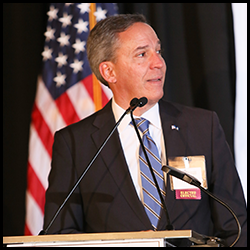

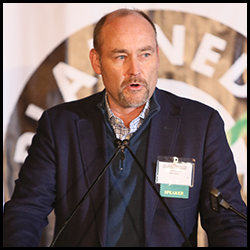
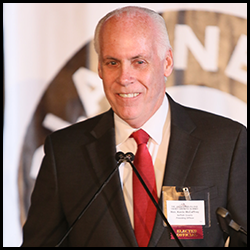
Hon. Jack Martins, New York State Senator – “Always great to be here, let us take a moment to remember back 25 years. Remember how tough it was to build consensus around the idea of downtown revitalization. The idea that we can actually build smartly in our downtowns because we needed diversity, housing, labor, a clean environmental, and overall investment in our downtowns. This all happened over the course of the last 25 years due in large part through the effort of people right here in this room, like Eric Alexander and Vision, Long Island. We need to keep working on providing infrastructure money to protect our environment, our coastal wetlands, and our sole source aquifer.”
Magda Campbell, AT&T – “Thank you for the partnerships that have been ongoing to keep growing the telecommunication infrastructure in this region. Thank you Eric Alexander for your leadership and vision. Happy 25th Year Anniversary.”
Jason Lipiec, M&T Bank – “When I look around at all the banners hanging up, it shows me the combined efforts of everybody in this room that go into making Long Island a great place; however, without Eric Alexander’s leadership and Vision Long Island, we would not be where we are today. M&T is proud to support Eric and his team. We at M&T are a community, hyper-local focused, and we are here to stay.”
Hon. Kevin McCaffrey, Suffolk County Presiding Officer – “Thank you Eric for 25 years. I remember 25 years ago, I was Deputy Mayor in the Village of Lindenhurst. We started doing great things together and Lindenhurst is now one of those vibrant downtowns we all talk about. It is really great to be here today. It is great to be part of this organization that has provided the impetus for us to move forward, connecting people across Long Island, in order to do the things that we need to get done for Long Island. The county has done some great things this year. We passed a one eighth percent sales tax, which is going to enable us to ensure that we have clean water in Suffolk County for many years to come. County Executive Ed Romaine and I share the same ideas about renewable energy, economic development, and affordable housing. We need to pursue all these issues to make sure that Suffolk County, and Nassau County because this is a region, continues to be successful for many years to come.”
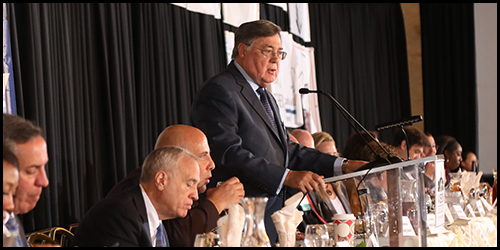
Featured Speaker - Hon. Ed Romaine, Suffolk County Executive
“Eric and Vision Long Island, congratulations on 25 years of great accomplishments. Well, here we are at the smart growth summit, and vision is what we need now more than ever. Downtowns define our communities, they define Long Island. For our downtowns to be successful, we need housing to be built and we need sewers. I cannot thank the voters of Suffolk County enough who approved, by 72%, the water referendum. In the next three years of my tenure, we will spend at least a billion dollars putting in sewers, and that is truly just a drop in the bucket. As I have tried to explain to our governor, Long Island can be one of the economic engines of this state and we need economic engines now more than ever because New York State has lost more population as a percentage than any other state in the Union. I have also told the governor, give me the sewers and we will give you the housing projects because we need more housing, particularly more affordable housing.”
“We need to get our fair share. We need technology and electrification. We are talking about congestion pricing, how much of that is going to be invested in Long Island? I have not gotten an answer. We need investment in our rail. We need to figure out ways that we can recycle ash and glass. Our challenges are many, but I look out at this room and that gives me confidence because we have a lot of smart and very capable people here, but I also look at what is happening to the rest of the state and I worry. I worry about our rail network, infrastructure, how we are handling garbage, water quality, including water reuse and recharging our aquifer. This is why I so appreciate Vision Long Island. The one thing we cannot be is silent. We have to speak up for the future of the Island. Why are we being shortchanged on transportation aid? Why do we not have the DEC working with us to make more goods recyclable so we do not have the garbage problems? We are all Long Islanders. We can be an economic engine for the State of New York and for the United States of America. The future is ours to make.”
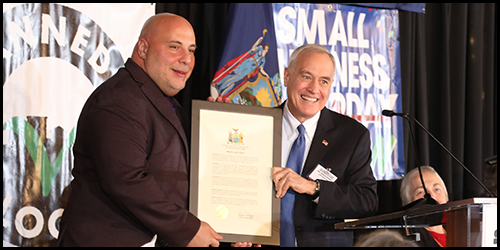
Keynote Speaker - Hon. Thomas DiNapoli, NYS Comptroller
“It really is a pleasure to be here. To Eric Alexander, Trudy Fitzsimmons, all the board members, and the staff of Vision Long Island, congratulations on 25 years. On this, the 23rd Smart Growth Summit, I looked at the agenda and all the issues you covered; affordable housing, downtown revitalization, clean energy, transportation, water and the environment, economic development, small business, and your youth summit. This is all about the future of our communities. I share your view that the only way we can achieve real sustainable solutions is by finding common ground, getting as close as possible to a consensus. As difficult as that can be, this is where Vision Long Island really has been such a key convener - bringing together our municipalities, our school districts, local organizations, and nonprofits, making sure everyone has a voice at the table. I really do applaud you for all that you have done. I also commend the sponsors of the summit and thank you for being supportive of the vision of Vision Long Island.”
“When people ask me about Long Island, I say Long Island is a region. We have our identification as Suffolk residents and Nassau residents, but we really are a collection of small towns and we recognize there is no one size fits all solutions to very big issues. Although the issues are similar in every community, the solutions really will be different. Long Island, and all of New York State, is still very much affected by the COVID pandemic experience. We are still on a path of recovery that is not complete, but fortunately it is moving in the right direction. We see on a statewide basis unemployment is down to a little over 4%, and Long Island just over 3%. Long Island is one of the regions where we have not only grown back all the jobs that were lost, we have actually added to the employment levels, which are higher in 2024 than they were in 2019. Long Islanders are making a difference, with businesses and communities working together.”
“The good news is our state finances have also been recovering. There are challenges because there is always a lot of competing interests in terms of issues and there is always competition for dollars. I am going to be optimistic, it is going to be a decent budget year next year. One of the key areas we all have been hearing a lot about in recent months certainly has to do with the MTA. Public transit certainly is a very key issue for all of us downstate. A very important part of any economy is having quality public transportation. The big issue has been congestion pricing and we all probably have different opinions if we go around the room. My perspective on this always has been, we need to fund the MTA's capital plan. If you do not want congestion pricing, come up with another way to pump $15 billion into the capital plan. Do not just say you're against congestion pricing. Public transit, be it New York City subways, Long Island Railroad, Metro North, the bus systems, needs to be kept in a state of good repair. My understanding from the current structure is that 10% of the revenue from congestion pricing will be set aside for the Long Island Railroad. The future of the Long Island Railroad is obviously essential to Nassau and Suffolk counties. Making sure the MTA has a fully funded capital plan needs to be an imperative.”
“Our [audit] report showed that New York State consistently ranks as one of the states with the highest cost burdens, both for owners and renters. We have a lot of work to do here. Again, solutions are not so simple. We know we need more quantity of housing, but when you get into the nitty gritty of where you put it, that is where there is some disagreements. I think one of the positive changes that we got from the governor is the move away from mandates as far as housing on Long Island to instead providing incentives. I think this was a good change of direction. I think again, because of an organization like Vision Long Island, we are uniquely positioned to take full advantage of those incentive opportunities. Our report also recommended to our local governments that they review and update zoning regulations and eliminate unnecessary restrictions to facilitate increased development.”
“There are broad challenges in our state. I think we need to pay attention to the healthcare issue from a cost perspective. It is always very controversial when you try to curtail costs, such as school aid. What came out of this year's budget process was a requirement for the Rockefeller Institute to come up with a study of the foundation aid formula, how we fund our public schools, how we distribute state aid, and that report has just come out. It listed a number of options. How many of those options will be included in the governor's budget presentation remains to be seen. If you do not want to see those changes, it is very important you engage with your legislators to let them know how you feel.”
“We have very ambitious goals in New York State to deal with the issue of climate, and we certainly have big energy needs as well. If we are going to meet those goals, we have a lot more work to do and Long Island needs to be engaged in that discussion as well. I think the big unknown for all of us as we head into the future is what will be the impact of the new administration in Washington with regard to federal funding for a whole host of programs. Will there be a change in terms of the federal funding formulas? Will our state or region be disadvantaged by some of the political changes? It is important for us to be in touch with our federal representatives to make sure that we are not compromised because of the impact it could potentially have on New York State's budget and our localities.”

You can view the complete Luncheon session here.
Special thanks to all the elected and appointed officials who joined us this year!
NYS Officials included:
Hon. Tom Dinapoli, NYS Comptroller;
Hon. Jack Martins, NYS Senate; Hon. Mario Mattera, NYS Senate; Hon. Dean Murray, NYS Senate; Hon. Steve Rhoads, NYS Senate; Former NYS Senator Phil Boyle; Hon. Keith Brown, NYS Assembly; Hon. Jake Blumencranz, NYS Assembly; Hon. Michael Durso, NYS Assembly; Hon. Kim Jean Pierre, NYS Assembly; Hon. Michael Fitzpatrick, NYS Assembly; Hon. Ed Ra, NYS Assembly
County Officials included:
Hon. Rose Walker, Nassau County Legislator; Hon. Tom McKevitt, Nassau County Legislature; Hon. Delia Deriggi Whitton, Minority Leader Nassau County; Hon. Debra Mule, Nassau County Legislator; Hon. Carrie Solages, Nassau County Legislator; Hon. Arnie Drucker, Nassau County Legislator; Hon. Scott Davis, Nassau County Legislator; Hon. Seth Koslow, Nassau County Legislator; Hon. Ed Romaine, Suffolk County Executive; Hon. Kevin McCaffrey, Presiding Officer, Suffolk County; Hon. Jason Richberg, Minority Leader, Suffolk County; Hon. Vincent Puleo, Suffolk County Clerk; Hon. Steve Flotteron, Suffolk County Legislator; Hon. Steve Englebright, Suffolk County Legislator; Hon. Stephanie Bontempi, Suffolk County Legislator; Hon. James Mazzarella, Suffolk County Legislator; Former Suffolk County Legislator Tom Cilmi; Former Suffolk Legislator, Bridget Fleming;
Town Officials included:
Hon. Anthony Mannetta, Councilman, Town of Babylon; Hon. Duwayne Gregory, Councilman, Town of Babylon; Hon. Dan Panico, Town of Brookhaven, Supervisor; Hon. Michael Loguercio, Town of Brookhaven, Councilman; Hon. Neil Manzella, Town of Brookhaven Councilman; Hon. Ed Smyth, Supervisor, Town of Huntington; Hon. Andy Raia, Town of Huntington Clerk; Former Town of Huntington Councilwoman Tracey Edwards; Hon. Jorge Guadron, Councilman, Town of Islip; Hon. Mike Mcelwee, Councilman, Town of Islip; Hon. Jennifer Desena, Supervisor, Town of North Hempstead; Hon. Mariann Dalimonte, Councilwoman, Town of North Hempstead; Hon. Christine Liu, Councilwoman, Town of North Hempstead; Former Town of North Hempstead Clerk, Wayne Wink; Hon. Joseph Saladino, Supervisor, Town of Oyster Bay; Hon. Vicki Walsh, Councilwoman, Town of Oyster Bay; Hon. Steve Labriola, Councilman, Town of Oyster Bay; Hon. Jeff Pravato, Receiver of Taxes, Town of Oyster Bay; Hon. Ed Wehrheim, Town of Smithtown Supervisor; Hon. Tom Lohmann, Town of Smithtown Councilman; Hon. Tim Hubbard, Town of Riverhead Supervisor; Hon. Bob Kern, Town of Riverhead Councilman
City and Village Officials included:
Hon. Pam Panzenback, City of Glen Cove; Hon. John Bendo, City of Long Beach; Hon. Denis Siry, Village of Amityville; Hon. Mary Adams, Village of Babylon; Hon. Nora Haagensen, Village of Baxter Estates; Hon. John Valdini, Village of Brightwaters; Hon. Ralph Ekstrand, Village of Farmingdale; Hon. Cheryl Parisi, Village of Farmingdale; Renee Marcus, Village of Floral Park; Hon. Gary Lowendowski, Village of Flower Hill; Hon. Randall Rosenbaum, Village of Flower Hill; Hon. Bill Warner, Village of Great Neck Estates; Hon. Robert Kennedy, Village of Freeport; Hon. Jorge Martinez, Village of Freeport; Hon. Clariona Griffith, Village of Hempstead; Hon. Noah Burroughs, Village of Hempstead; Hon. Mike Mginty, Village of Island Park; Hon. Mike Lavorata, Village of Lindenhurst; Hon. RJ Renna, Village of Lindenhurst; Hon. Paul Perriera, Village of Mineola; Hon. Donna Koch, Village of Northport; Hon. Barbara Donno, Village of Plandome Manor; Hon. Sarah Oral, Village of Roslyn; Hon. Ed Fare, Village of Valley Stream; Tom McAleer, Village of Valley Stream; David Sabatino, Village of Valley Stream; Barbara Degrace, Village of Valley Stream; Hon. Bonnie Parente, Village of East Williston; Hon. Peter Cavallaro, Village of Westbury; George Graf, former Mayor, Village of Farmingdale
Additional officials included:
Adam Hornbuckle, Office of US Senator Chuck Schumer; Michael Schein, Office of US Senator Kirsten Gillibrand; Sam Salazar, Office of US Senator Kirsten Gillibrand; Mike Caplice, Office of NYS Comptroller Tom Dinapoli; Stevens Martinez, Office of Governor Kathy Hochul; Rob Calarco, Office of Governor Kathy Hochul; Neal Lewis, Nassau County Planning Commission; Adrienne Esposito, Suffolk County Planning Commission; Leah Jefferson, Suffolk County Community Development Agency; Sarah Lansdale, Suffolk County Economic Development; Chris Fusco, Nassau County Department of Labor; Lionel Chitty, Nassau County Office of Minority Affairs
Check out media coverage of the 2024 Long Island Smart Growth Summit at these excellent news outlets

Newsday

Long Island Business News
Long Island Busines News Editorial

Long Island Life and Politics
Additional Stories at:
 &
& 
We are now accepting nominations for
the 2024 Long Island Smart Growth Awards!
You can download a PDF version of this flyer here.
Save the Date for the upcoming
Long Island Complete Streets Summit
You can download a PDF version of this flyer here.
Please join us for the upcoming
Long Island Youth Summit!
You can download a PDF version of this flyer here.
Join us for Lobby Day
as we take our message to Albany!
You can download a PDF version of this flyer here.
Help us to improve Long Island!
You can download a PDF version of this flyer here.
You can download a PDF version of this flyer here.
Special thanks to our Board members!

Vision Long Island
24 Woodbine Ave., Suite Two
Northport, NY 11768
Phone: 631-261-0242. Fax: 631-754-4452.
Email: info@visionlongisland.org
Website: www.visionlongisland.org
 |
|
Home | Contact Us | Newsletter Archive | Donate | About Us

